Dynamic and Residual Static Behavior of Axially Loaded RC Columns Subjected to Low-Elevation Impact Loading
Abstract
1. Introduction
2. Experimental Preparation and Materials
2.1. Experimental Program
2.2. Preparation of Specimens
2.3. Test Setup
2.4. Data Collection
2.5. Material Properties of the Specimens
3. Experimental Study
3.1. Static Test Results
3.2. Impact Test Results
3.2.1. Axial Load
3.2.2. Support Reactions
3.2.3. Deflections
3.2.4. Failure Modes
3.3. Residual Capacity Tests
3.3.1. Residual Capacities
3.3.2. Energy Dissipation
4. Numerical Study
4.1. Developing the Finite Element Models
4.2. The Validation of the Model
4.3. Finite Element Analysis: The Effect of the Impact Energy on the Structural Behavior
4.4. Comparison of the Numerical and Experimental Results
5. Conclusions
- By the increasing impact energy, the dominant behavior changed gradually from flexure to shear in axially loaded columns under low-elevation impacts.
- The displacement and damage levels in the specimens continued to increase until the specimens reached their failure state, and at the highest impact energy levels, buckling occurred in the top longitudinal reinforcements, causing total failure.
- Under higher applied impact energies, the rate of the decrease in the stiffnesses, residual load carrying and deflection capacities increased.
- By increasing the impact energy, the ratio of the impact energy dissipation to the static energy dissipation capacity loss (DIF) for the specimens increased from 1.40 to 1.63.
- A good agreement was observed between the developed FE model and the test results. Based on the simulation results, axially loaded reinforced concrete columns with similar properties reached the impact capacity with a dropping height of 600 cm, where remarkably reduced stiffness, strength and displacement capacities, as well as obvious heavy damages, observed.
6. Recommendations
- i
- This research provided many findings regarding the impact behavior and post-impact behavior of reinforced concrete columns; however, the study should be expanded by examining the effects of different axial load levels, reinforcement configurations, impact energies and boundary conditions for future research.
- ii
- The developed FE model can be used in future studies to investigate the effects of different parameters on the impact behavior of RC columns.
Author Contributions
Funding
Data Availability Statement
Acknowledgments
Conflicts of Interest
References
- Zhang, C.; Gholipour, G.; Mousavi, A.A. State-of-the-Art Review on Responses of Structures Subjected to Lateral Impact Loads. Arch. Comput. Methods Eng. 2021, 28, 2477–2507. [Google Scholar] [CrossRef]
- Saatci, S.; Vecchio, F.J. Effects of Shear Mechanisms on Impact Behavior of Reinforced Concrete Beams. ACI Struct. J. 2009, 106, 78–86. [Google Scholar] [CrossRef][Green Version]
- Banthia, N.P. Impact Resistance of Concrete. Ph.D. Thesis, Department of Civil Engineering, University of British Columbia, Vancouver, BC, Canada, 1987. [Google Scholar][Green Version]
- Yankelevsky, D.Z.; Karinski, Y.S.; Feldgun, V.R. Damage and Failure of a Column-Supported RC Flat Slab Subjected to Impulsive Loading. Appl. Sci. 2023, 13, 1933. [Google Scholar] [CrossRef]
- Yankelevsky, D.Z.; Karinski, Y.S.; Feldgun, V.R. Dynamic punching shear failure of a RC flat slab-column connection under a collapsing slab impact. Int. J. Impact Eng. 2020, 135, 103401. [Google Scholar] [CrossRef]
- Mougin, J.P.; Perrotin, P.; Mommessin, M.; Tonnelo, J.; Agbossou, A. Rock fall impact on reinforced concrete slab: An experimental approach. Int. J. Impact Eng. 2005, 31, 169–183. [Google Scholar] [CrossRef]
- Zineddin, M.; Krauthammer, T. Dynamic response and behavior of reinforced concrete slabs under impact loading. Int. J. Impact Eng. 2007, 34, 1517–1534. [Google Scholar] [CrossRef]
- Dok, G.; Caglar, N.; Ilki, A.; Yilmaz, C. Effect of impact loading on residual flexural capacity of high-strength reinforced concrete beams. Structures 2020, 27, 2466–2480. [Google Scholar] [CrossRef]
- Yilmaz, C.; Kirtel, O.; Dok, G.; Ilki, A. Experimental Investigation on the Post-impact Behavior of Normal-Strength Reinforced Concrete Beams Subjected to Drop-Weight Impact Loads. Arab. J. Sci. Eng. 2023, 48, 13241–13258. [Google Scholar] [CrossRef]
- Adhikary, S.D.; Fujikake, K.; Li, B. State-of-the-art review on low-velocity impact response of reinforced concrete beams. Mag. Concr. Res. 2016, 68, 701–723. [Google Scholar] [CrossRef]
- Soleimani, S.M.; Banthia, N.; Mindess, S. Behavior of RC beams under impact loading: Some new findings. In Proceedings of the 6th International Conference on Fracture Mechanics of Concrete and Concrete Structures; Taylor & Francis: London, UK, 2007; Volume 2, pp. 867–874. Available online: https://framcos.org/FraMCoS-6/195.pdf (accessed on 10 November 2023).
- Wang, X.; Zhang, Y.; Su, Y.; Feng, Y. Experimental Investigation on the Effect of Reinforcement Ratio to Capacity of RC Column to Resist Lateral Impact Loading. Int. Conf. Risk Eng. Manag. 2011, 1, 35–41. [Google Scholar] [CrossRef]
- Remennikov, A.; Kaewunruen, S. Impact Resistance of Reinforced Concrete Columns: Experimental Studies and Design Considerations. University of Wollongong Research Online. 2006. Available online: http://ro.uow.edu.au/engpapers/379 (accessed on 10 November 2023).
- Yilmaz, A.; Kiraç, N.; Anil, Ö. Experimental investigation of axially loaded reinforced concrete square column subjected to lateral low-velocity impact loading. Struct. Concr. 2019, 20, 1358–1378. [Google Scholar] [CrossRef]
- Li, H.; Chen, W.; Huang, Z.; Hao, H.; Ngo, T.T.; Pham, T.M. Influence of various impact scenarios on the dynamic performance of concrete beam-column joints. Int. J. Impact Eng. 2022, 167, 104284. [Google Scholar] [CrossRef]
- Cai, J.; Ye, J.-B.; Chen, Q.-J.; Liu, X.; Wang, Y.-Q. Dynamic behaviour of axially-loaded RC columns under horizontal impact loading. Eng. Struct. 2018, 168, 684–697. [Google Scholar] [CrossRef]
- Song, Y.; Wang, J.; Han, Q. Dynamic performance of flexure-failure-type rectangular RC columns under low-velocity lateral impact. Int. J. Impact Eng. 2023, 175, 104541. [Google Scholar] [CrossRef]
- Zhu, X.; Zhao, P.; Tian, Y.; Wang, R. Experimental study of RC columns and composite columns under low-velocity impact. Thin-Walled Struct. 2021, 160, 107374. [Google Scholar] [CrossRef]
- Yunlei, W.; Lu, Z.; Hai, F.; Weiqing, L.; Yifeng, M. Experimental testing and numerical simulations of ship impact on axially loaded reinforced concrete piers. Int. J. Impact Eng. 2019, 125, 246–262. [Google Scholar] [CrossRef]
- Liu, B.; Fan, W.; Guo, W.; Chen, B.; Liu, R. Experimental investigation and improved FE modeling of axially-loaded circular RC columns under lateral impact loading. Eng. Struct. 2017, 152, 619–642. [Google Scholar] [CrossRef]
- Chen, L.; Xiao, Y.; El-Tawil, S. Impact Tests of Model RC Columns by an Equivalent Truck Frame. J. Struct. Eng. 2016, 142, 04016002. [Google Scholar] [CrossRef]
- Fan, W.; Shen, D.; Yang, T.; Shao, X. Experimental and numerical study on low-velocity lateral impact behaviors of RC, UHPFRC and UHPFRC-strengthened columns. Eng. Struct. 2019, 191, 509–525. [Google Scholar] [CrossRef]
- Lee, J.-Y.; Aoude, H.; Yoon, Y.-S.; Mitchell, D. Impact and blast behavior of seismically-detailed RC and UHPFRC Strengthened columns. Int. J. Impact Eng. 2020, 143, 103628. [Google Scholar] [CrossRef]
- Zhou, X.; Ming, Z.; Luo, D.; Wu, B.; Liu, L. Study on the nonlinear response and shear behavior of RC columns under lateral impact. Structures 2021, 34, 3834–3850. [Google Scholar] [CrossRef]
- Yuan, P.; Harik, I.E. Equivalent Barge and Flotilla Impact Forces on Bridge Piers. J. Bridge Eng. 2010, 15, 523–532. [Google Scholar] [CrossRef]
- Tantrapongsaton, W.; Hansapinyo, C.; Limkatanyu, S.; Zhang, H.; Vimonsatit, V. Nonlinear Response of RC Columns Subjected to Equal Energy-Double Impact Loads. Buildings 2022, 12, 1420. [Google Scholar] [CrossRef]
- Li, X.; Yin, Y.; Li, T.; Zhu, X.; Wang, R. Analytical Study on Reinforced Concrete Columns and Composite Columns under Lateral Impact. Coatings 2023, 13, 152. [Google Scholar] [CrossRef]
- Auyeung, S.; Alipour, A.; Saini, D. Performance-based design of bridge piers under vehicle collision. Eng. Struct. 2019, 191, 752–765. [Google Scholar] [CrossRef]
- Do, T.V.; Pham, T.M.; Hao, H. Impact force profile and failure classification of reinforced concrete bridge columns against vehicle impact. Eng. Struct. 2019, 183, 443–458. [Google Scholar] [CrossRef]
- Abdelkarim, O.I.; ElGawady, M.A. Performance of bridge piers under vehicle collision. Eng. Struct. 2017, 140, 337–352. [Google Scholar] [CrossRef]
- Thilakarathna, H.M.I.; Thambiratnam, D.P.; Dhanasekar, M.; Perera, N. Numerical simulation of axially loaded concrete columns under transverse impact and vulnerability assessment. Int. J. Impact Eng. 2010, 37, 1100–1112. [Google Scholar] [CrossRef]
- Sharma, H.; Hurlebaus, S.; Gardoni, P. Performance-based response evaluation of reinforced concrete columns subject to vehicle impact. Int. J. Impact Eng. 2012, 43, 52–62. [Google Scholar] [CrossRef]
- Sohel, K.M.A.; Al-Jabri, K.; Al Abri, A.H.S. Behavior and design of reinforced concrete building columns subjected to low-velocity car impact. Structures 2020, 26, 601–616. [Google Scholar] [CrossRef]
- Do, T.V.; Pham, T.M.; Hao, H. Impact Response and Capacity of Precast Concrete Segmental versus Monolithic Bridge Columns. J. Bridge Eng. 2019, 24, 04019050. [Google Scholar] [CrossRef]
- Hu, B.; Cai, J.; Jiabin, Y. Numerical Simulation of Dynamic Response and Evaluation of Flexural Damage of RC Columns under Horizontal Impact Load. Appl. Sci. 2021, 11, 11223. [Google Scholar] [CrossRef]
- Wang, W.; Chen, J.; Zhou, R.X.; Zhong, J. A simplified coupled model for predicting dynamic processes of vehicle impact on pier columns. Structures 2022, 41, 997–1013. [Google Scholar] [CrossRef]
- Zhao, W.; Ye, J. Dynamic behavior and damage assessent of RC columns subjected to lateral soft impact. Eng. Struct. 2022, 251, 113476. [Google Scholar] [CrossRef]
- Xie, R.; Fan, W.; Liu, B.; Dongjie, S. Dynamic behavior and vulnerability analysis of bridge columns with different cross-sectional shapes under rockfall impacts. Structures 2020, 26, 471–486. [Google Scholar] [CrossRef]
- Gholipour, G.; Zhang, C.; Mousavi, A.A. Effects of axial load on nonlinear response of RC columns subjectedto lateral impact load: Ship-pier collision. Eng. Fail. Anal. 2018, 91, 397–418. [Google Scholar] [CrossRef]
- Do, T.V.; Pham, T.M.; Hao, H. Dynamic responses and failure modes of bridge columns under vehicle collision. Eng. Struct. 2018, 156, 243–259. [Google Scholar] [CrossRef]
- Zhao, W.; Qian, J. Resistance mechanism and reliability analysis of reinforced concrete columns subjected to lateral impact. Int. J. Impact Eng. 2020, 136, 103413. [Google Scholar] [CrossRef]
- Wang, W.; Morgenthal, G. Dynamic analyses of square RC pier column subjected to barge impact using efficient models. Eng. Struct. 2017, 151, 20–32. [Google Scholar] [CrossRef]
- Demartino, C.; Wu, J.G.; Xiao, Y. Response of shear-deficient reinforced circular RC columns under lateral impact loading. Int. J. Impact Eng. 2017, 109, 196–213. [Google Scholar] [CrossRef]
- Li, R.W.; Zhou, D.Y.; Wu, H. Experimental and numerical study on impact resistance of RC bridge piers under lateral impact loading. Eng. Fail. Anal. 2020, 109, 104319. [Google Scholar] [CrossRef]
- AL-Bukhaiti, K.; Liu, Y.; Zhao, S.; Abas, H.; Xu, N.; Yang, L.; Yan, X.; Han, D. Experimental Study on Existing RC Circular Members Under Unequal Lateral Impact Train Collision. Int. J. Concr. Struct. Mater. 2022, 16, 39. [Google Scholar] [CrossRef]
- Chen, A.; Liu, Y.; Ma, R.; Zhou, X. Experimental and Numerical Analysis of Reinforced Concrete Columns under Lateral Impact Loading. Buildings 2023, 13, 708. [Google Scholar] [CrossRef]
- Gurbuz, T.; Ilki, A.; Thambiratnam, D.P.; Perera, N. Low-Elevation Impact Tests of Axially Loaded Reinforced Concrete Columns. ACI Struct. J. 2019, 116, 17–449. [Google Scholar] [CrossRef]
- Ye, J.-B.; Cai, J.; Chen, Q.-J.; Xinpei, L.; Tang, X.-L.; Zuo, Z.L. Experimental investigation of slender RC columns under horizontal static and impact loads. Structures 2020, 24, 499–513. [Google Scholar] [CrossRef]
- Ye, J.; Wang, Y.; Cai, J.; Chen, Q.; He, A. Evaluation of Residual Lateral Capacities of Impact Damaged Reinforced Concrete Members. Buildings 2022, 12, 669. [Google Scholar] [CrossRef]
- Fan, W.; Liu, B.; Consolazio, G.R. Residual Capacity of Axially Loaded Circular RC Columns after Lateral Low-Velocity Impact. J. Struct. Eng. 2019, 145, 04019039. [Google Scholar] [CrossRef]
- Wei, J.; Li, J.; Wu, C. An experimental and numerical study of reinforced conventional concrete and ultra-high performance concrete columns under lateral impact loads. Eng. Struct. 2019, 156, 375–393. [Google Scholar] [CrossRef]
- AL-Bukhaiti, K.; Liu, Y.; Zhao, S.; Abas, H.; Yu, Y.X.; Xu, N.; Han, D.; Lang, Y. Failure mechanism and static bearing capacity on circular RC members under asymmetrical lateral impact train collision. Structures 2023, 48, 1817–1832. [Google Scholar] [CrossRef]
- DEWE-43A; Technical Reference Manual. DEWESoft: Trbovlje, Slovenia, 2023. Available online: https://downloads.dewesoft.com/manuals/dewesoft-dewe-43a-manual-en.pdf (accessed on 10 November 2023).
- TDS-540; Data Logger Catalog. Tokyo Measuring Instruments Laboratory Co., Ltd.: Tokyo, Japan, 2023. Available online: https://www.tml.jp/eng/documents/Catalog/TDS-540_E3011F.pdf (accessed on 10 November 2023).
- DEWESoft X. User Manual; DEWESoft: Trbovlje, Slovenia, 2023; Available online: https://downloads.dewesoft.com/manuals/dewesoftx-getting-started-manual-en.pdf (accessed on 10 November 2023).
- TDS-7130v2; Static Measurement Software Catalog. Tokyo Measuring Instruments Laboratory Co., Ltd.: Tokyo, Japan, 2023. Available online: https://tml.jp/eng/documents/software/TDS-7130v2_E8002A.pdf (accessed on 10 November 2023).
- TS EN 12390-3; Testing Hardened Concrete-Part 3: Compressive Strength of Test Specimens. Turkish Standards Institution: Ankara, Turkey, 2019.
- TS 708; Steel for the Reinforcement of Concrete-Reinforcing Steel. Turkish Standards Institution: Ankara, Turkey, 2016.
- LS-DYNA. Theory Manual; Livermore Software Technolog: Livermore, CA, USA, 2019. [Google Scholar]
- LS-DYNA. Keyword User’s Manual Volume 1; Livermore Software Technolog: Livermore, CA, USA, 2021. [Google Scholar]
- LS-DYNA. Keyword User’s Manual Volume 2; Livermore Software Technolog: Livermore, CA, USA, 2021. [Google Scholar]



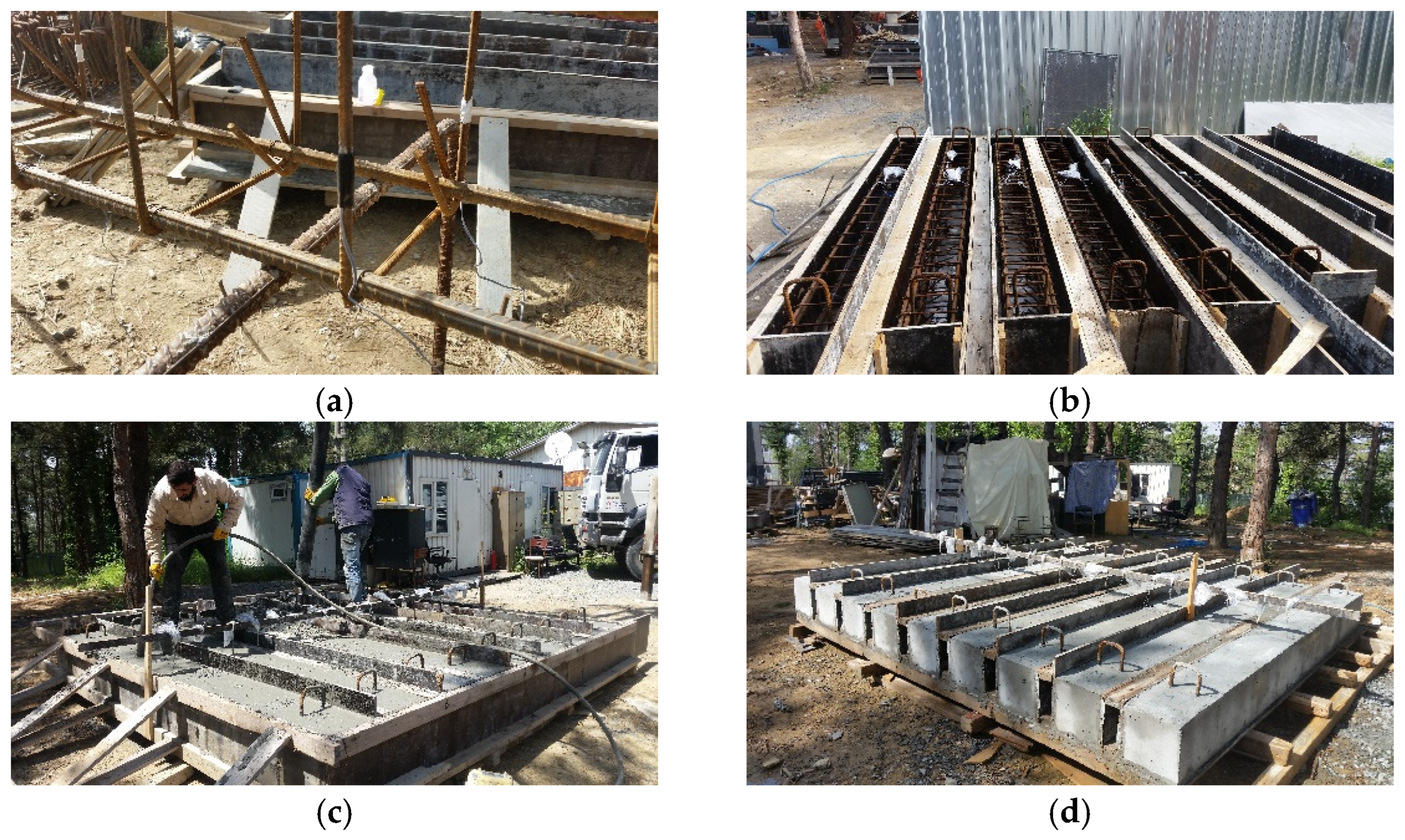

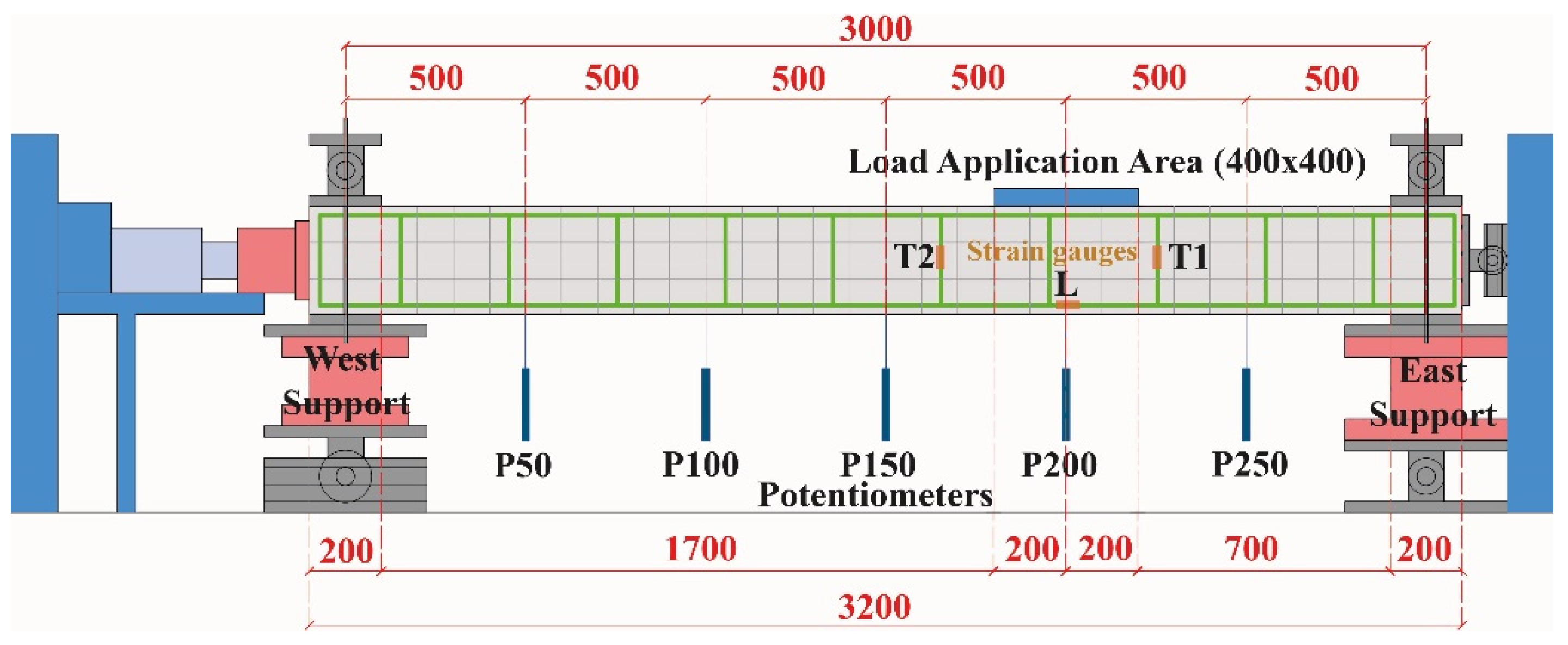
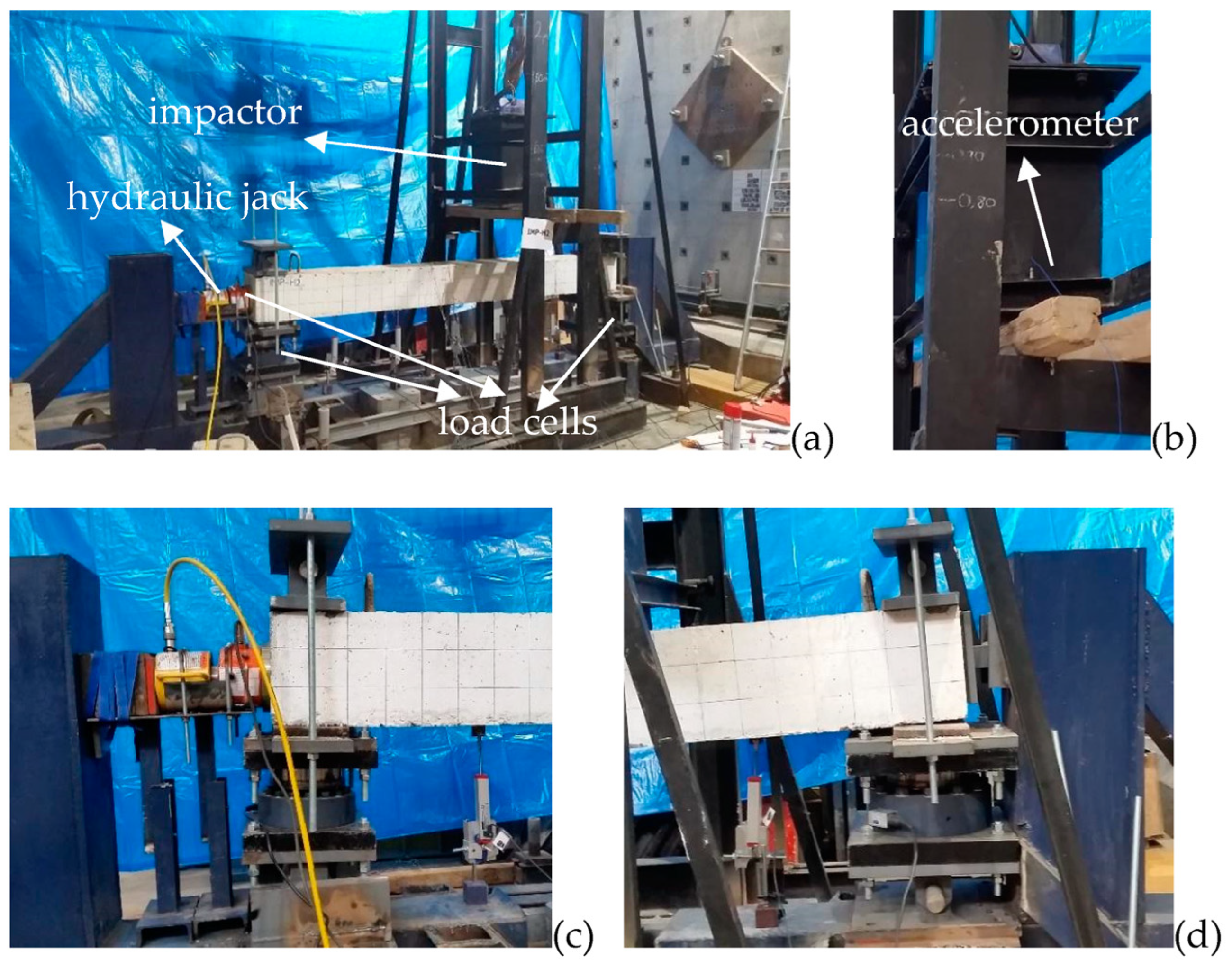
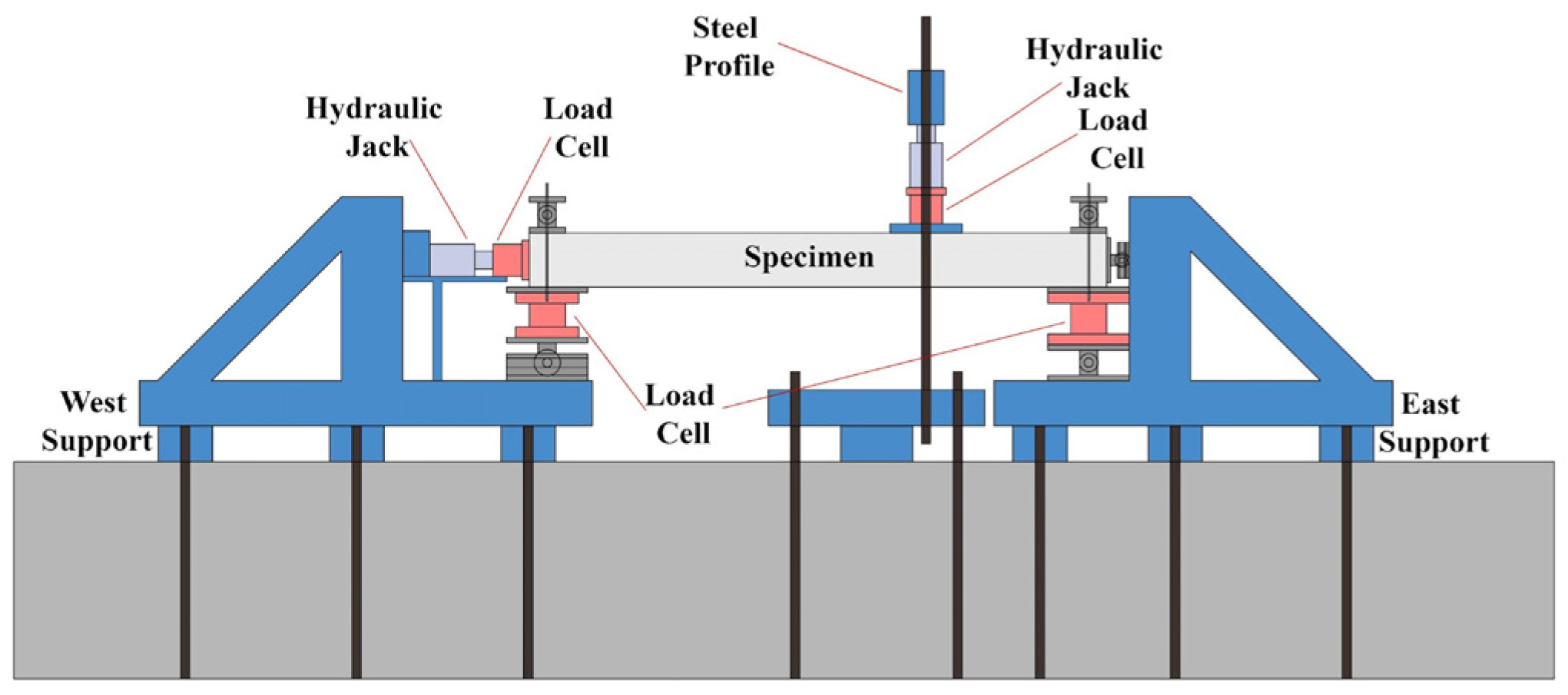
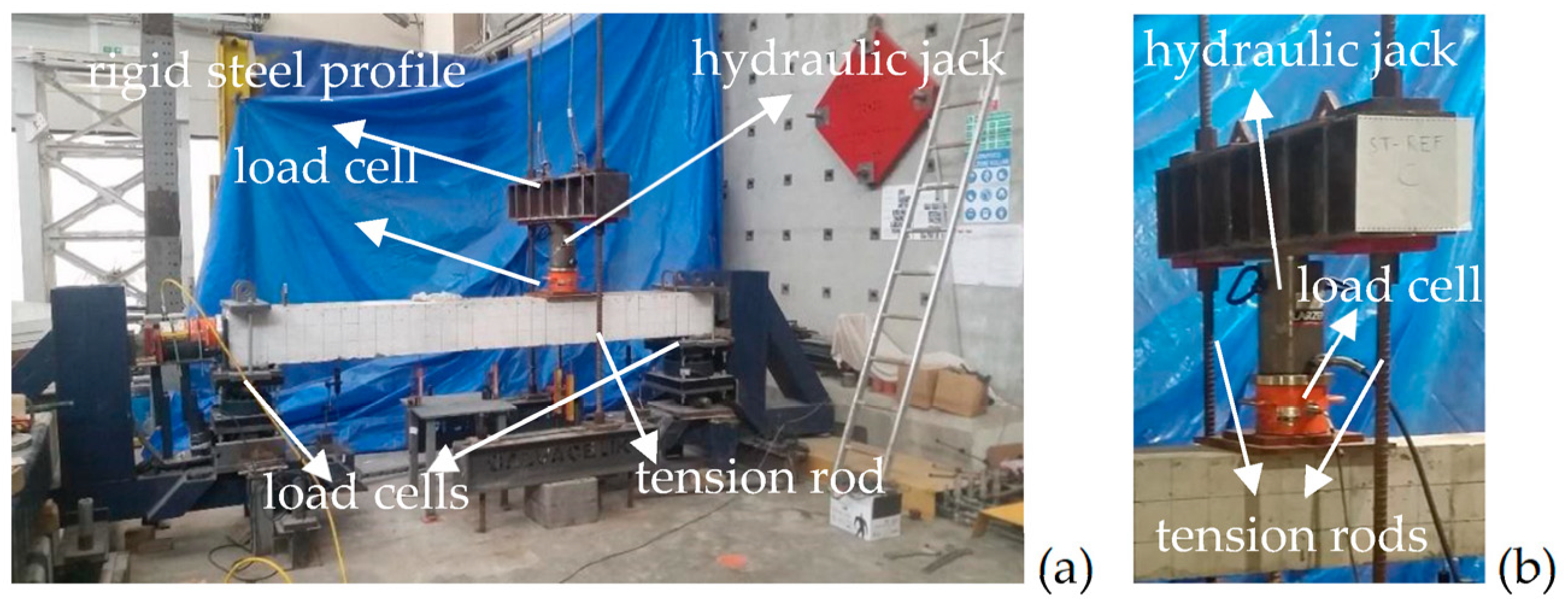

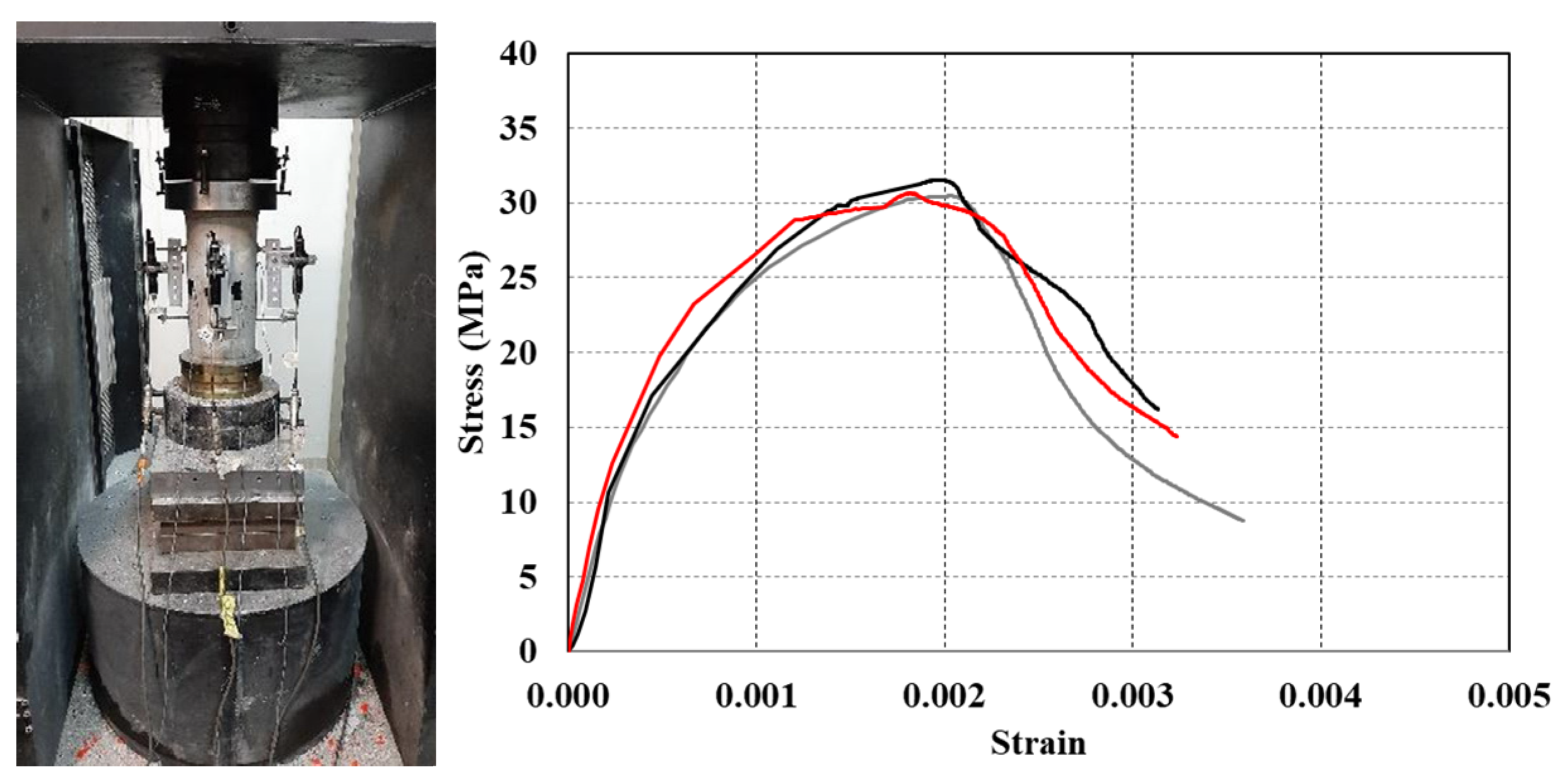

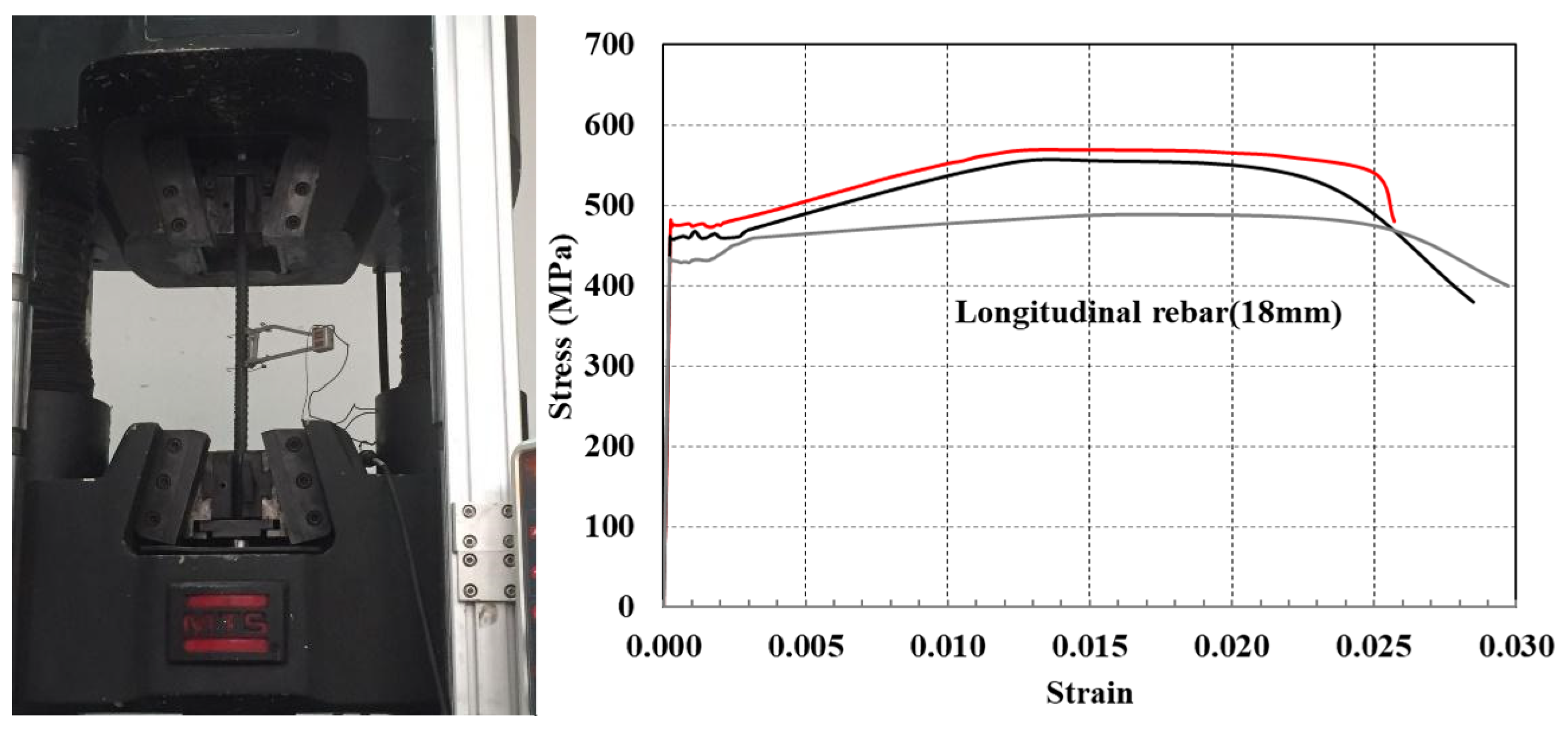
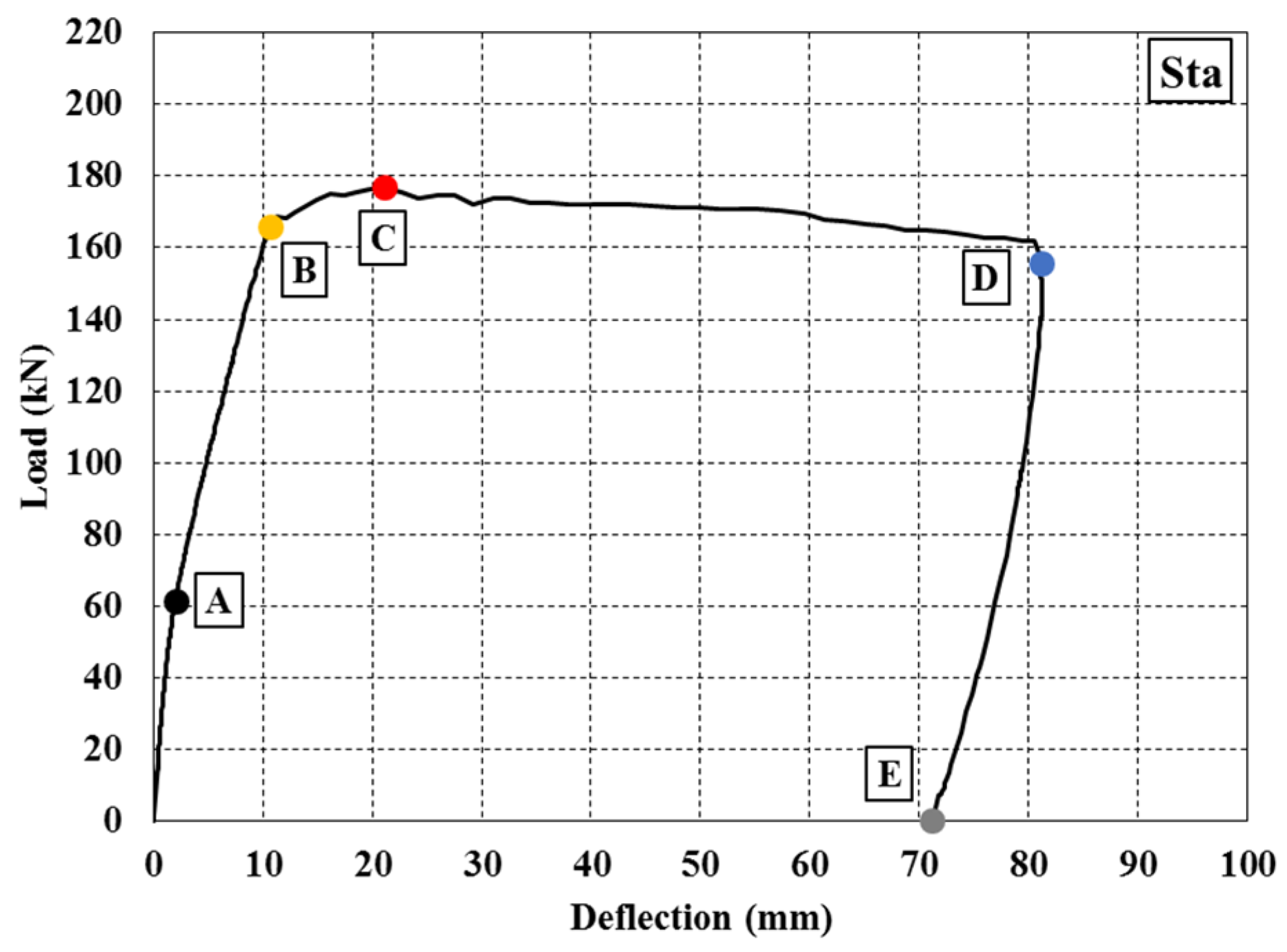
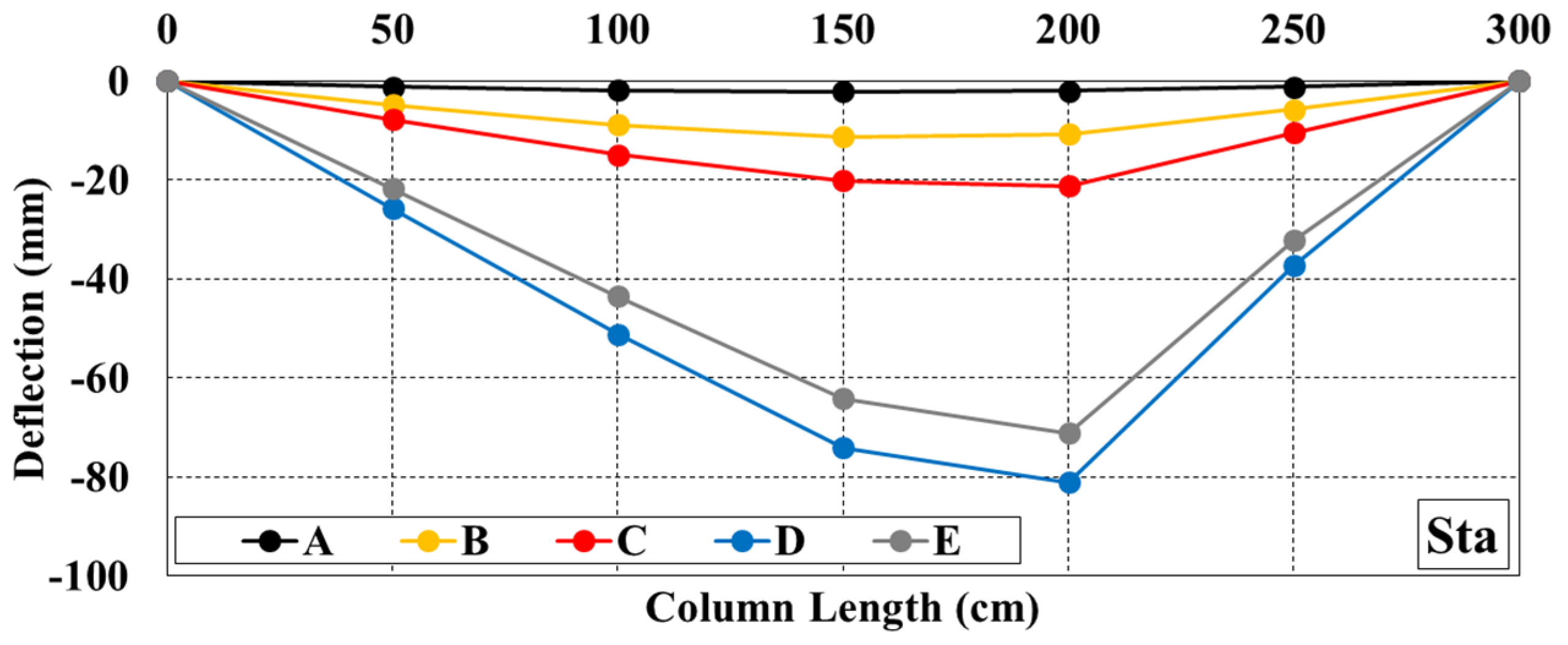
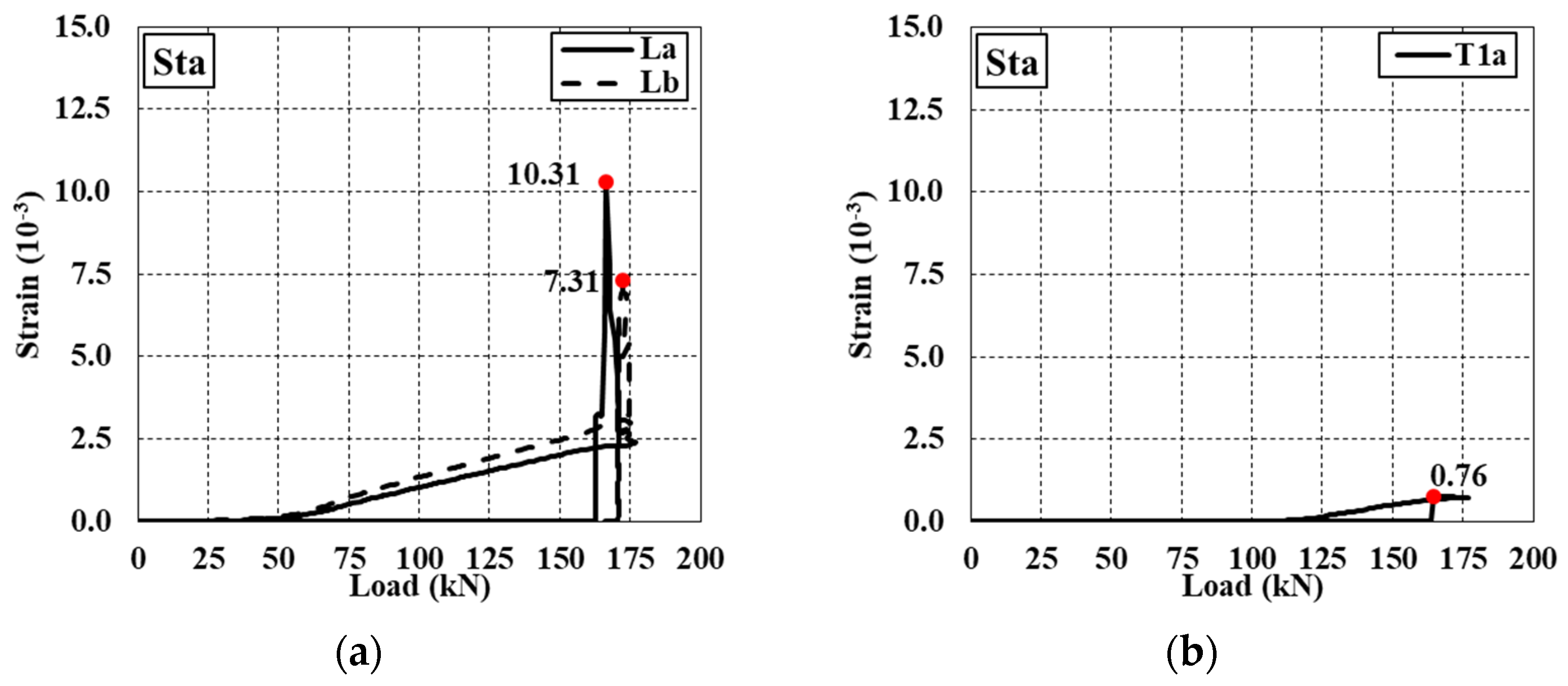


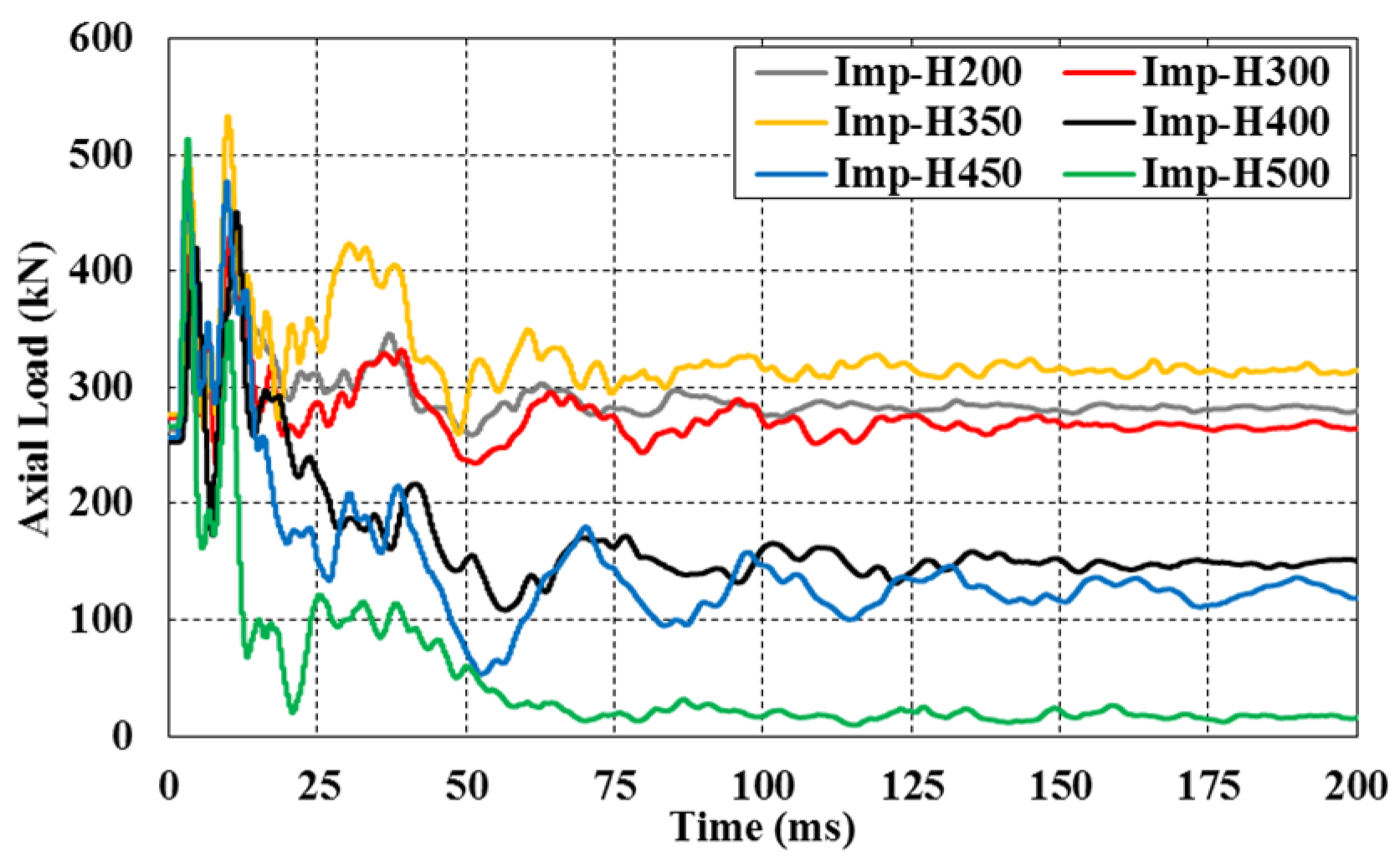

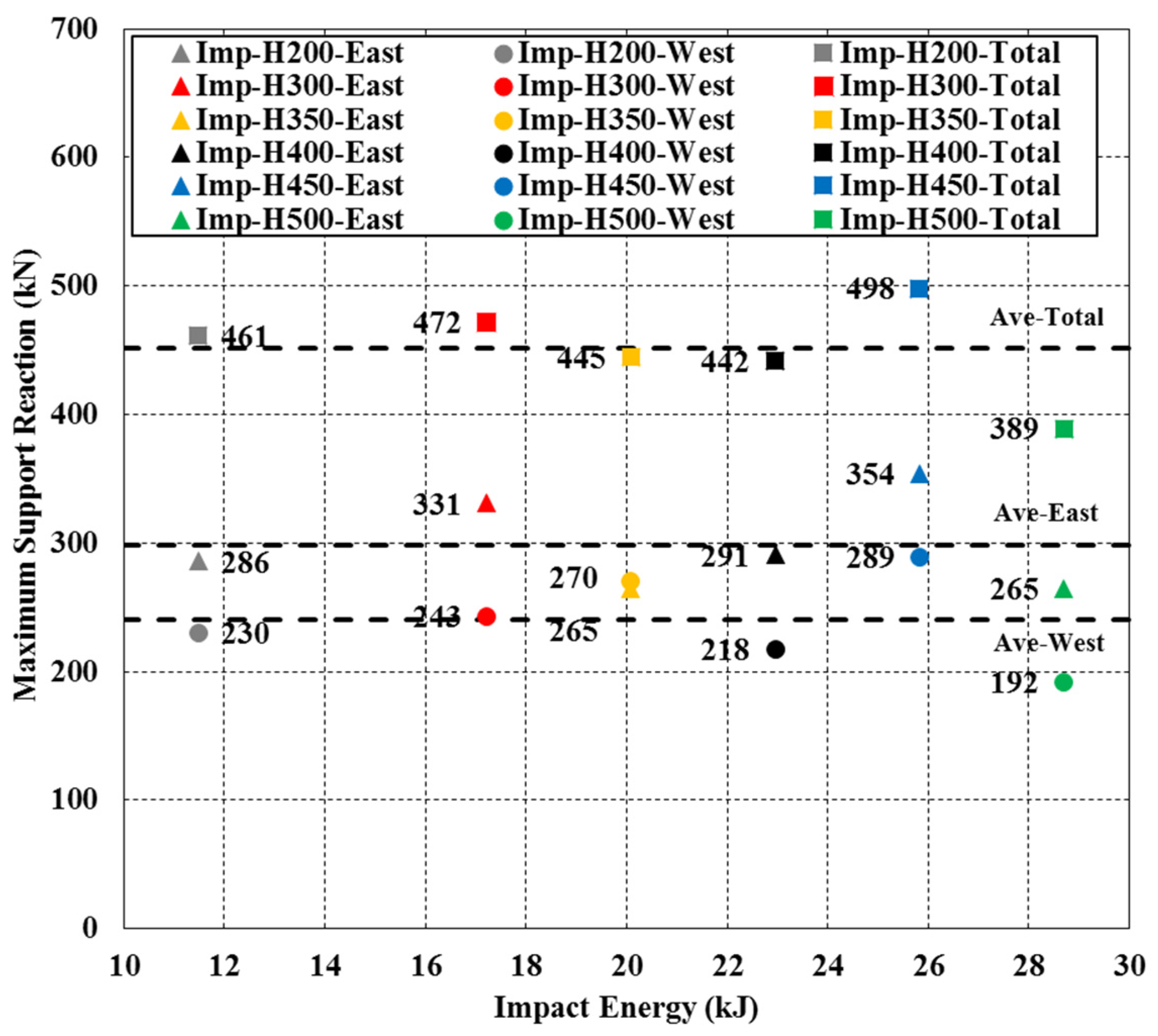

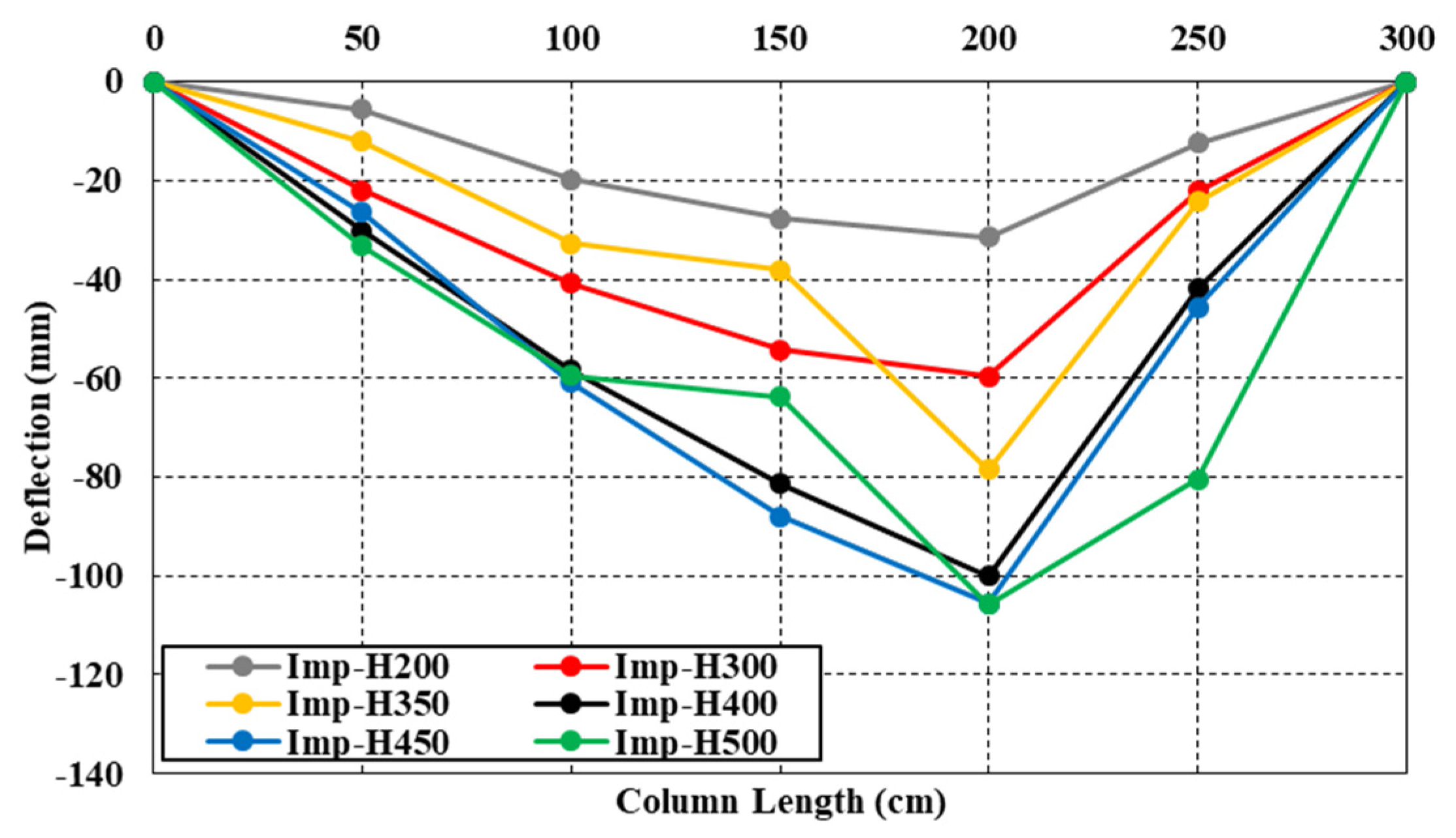

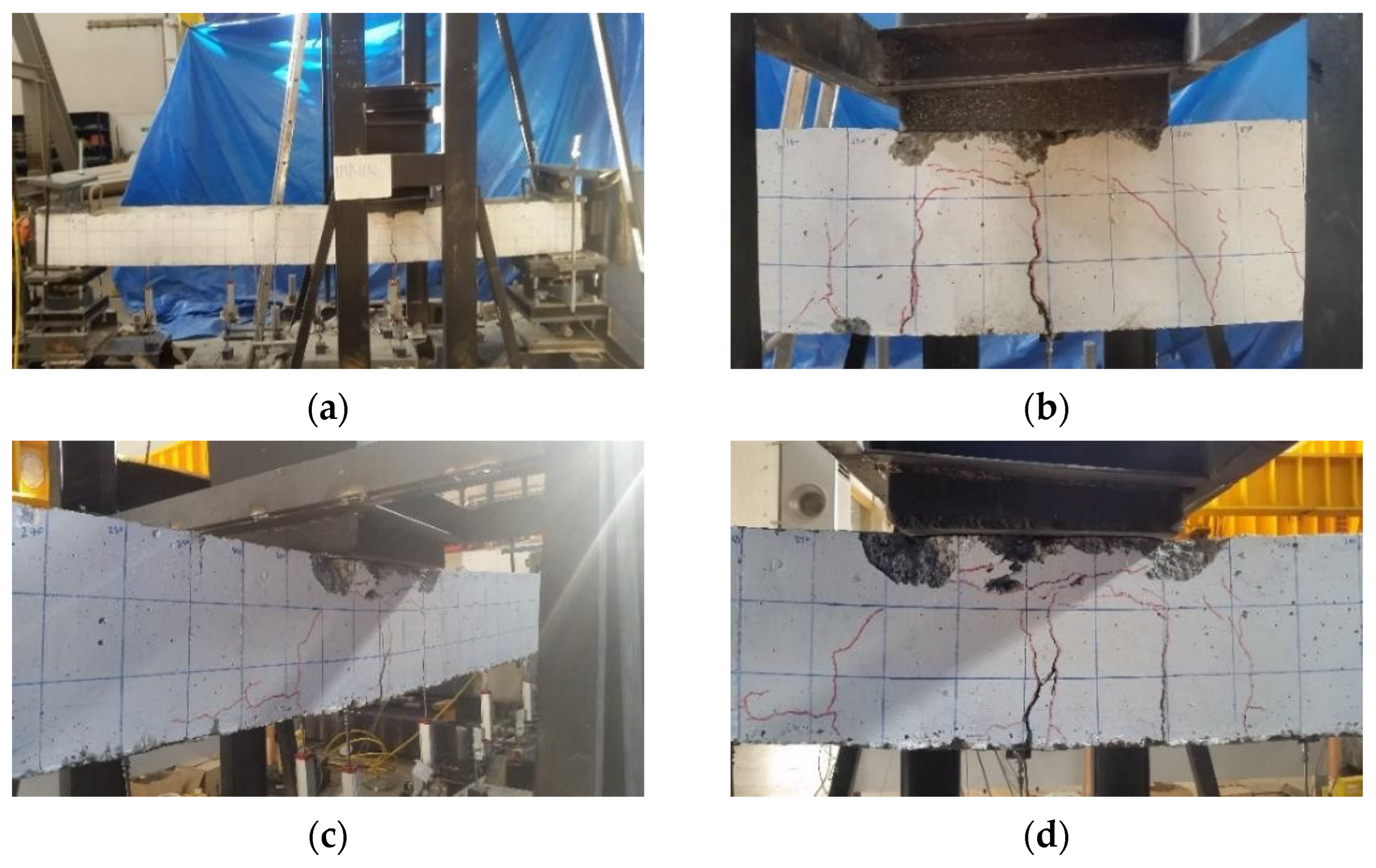

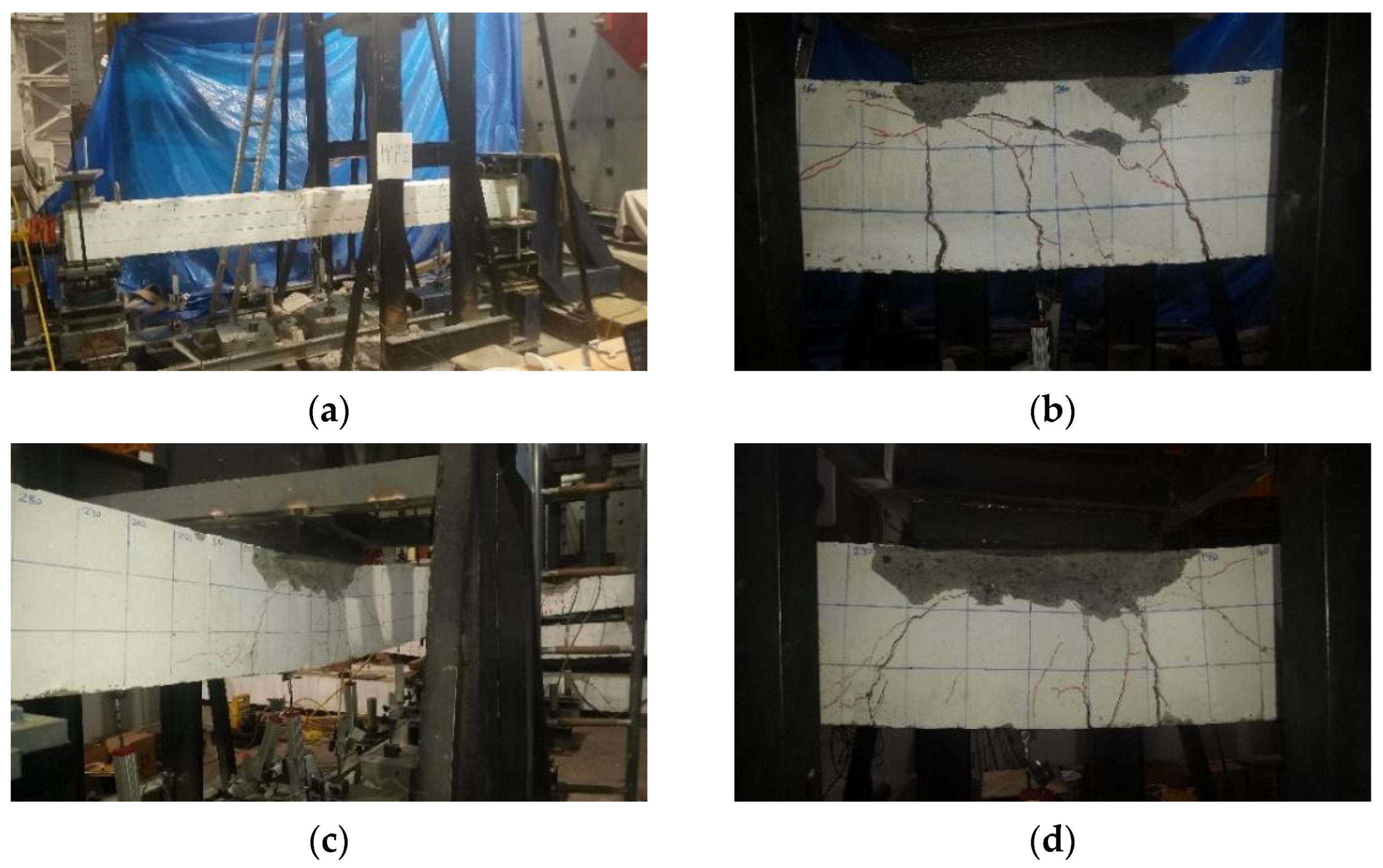



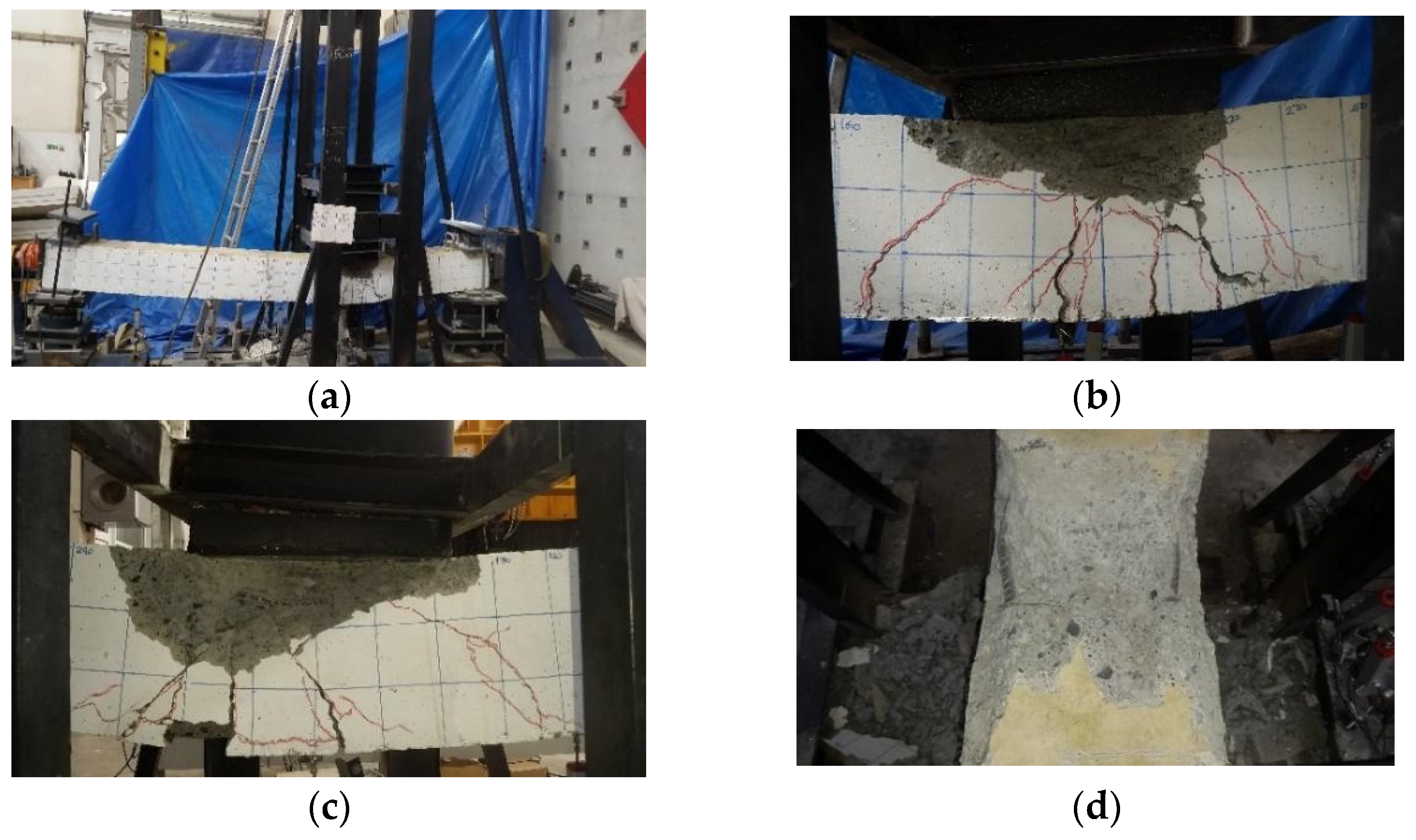




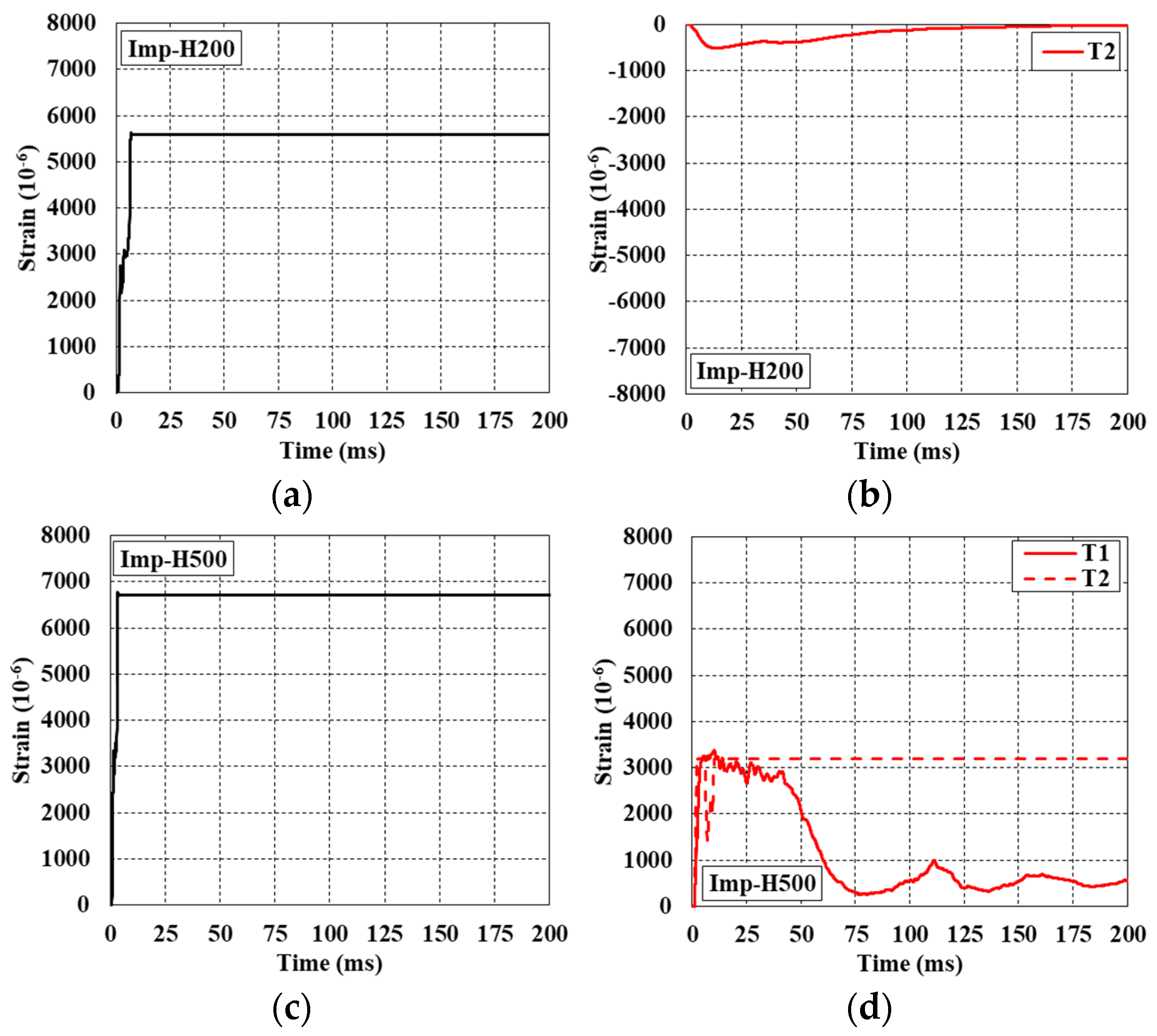
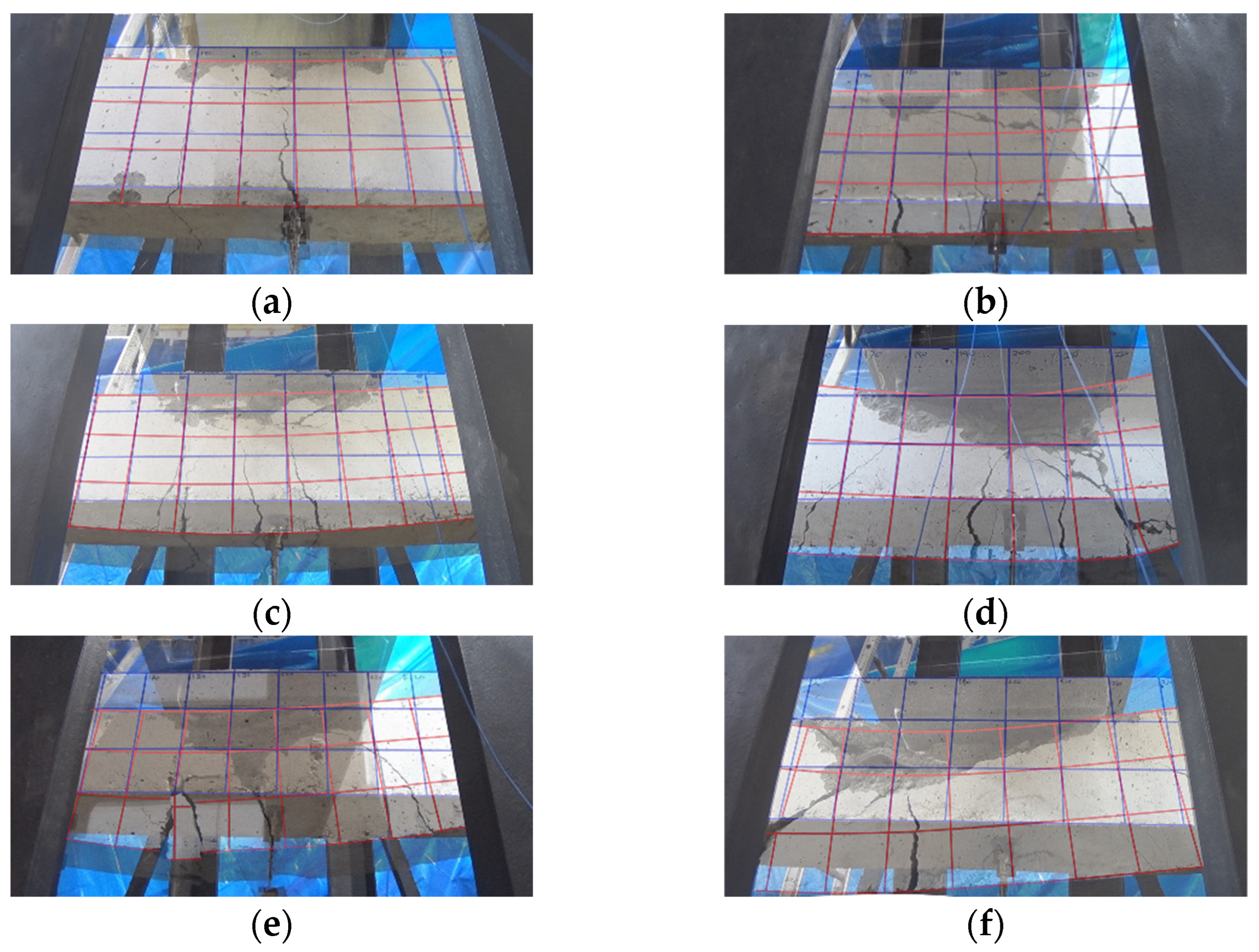
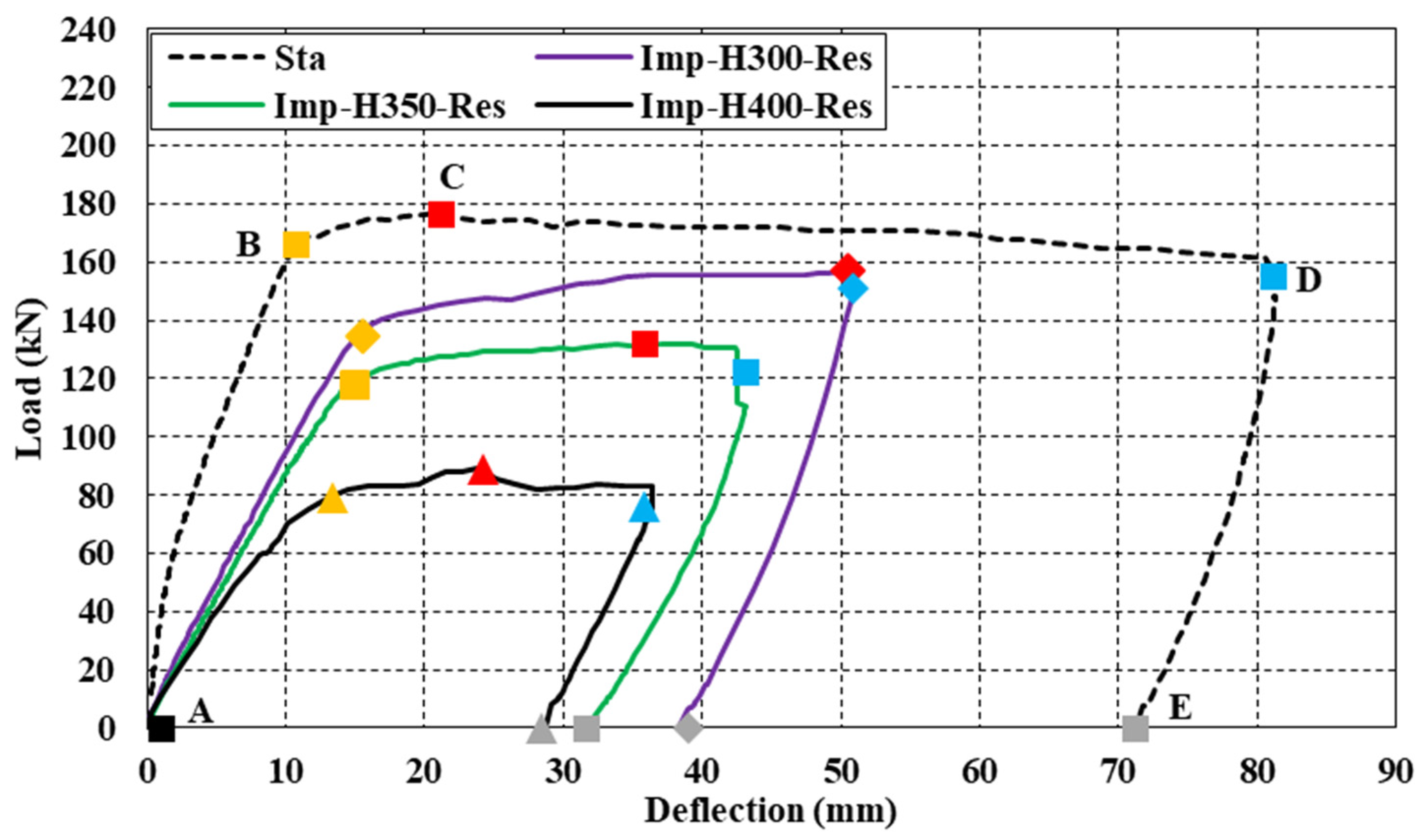
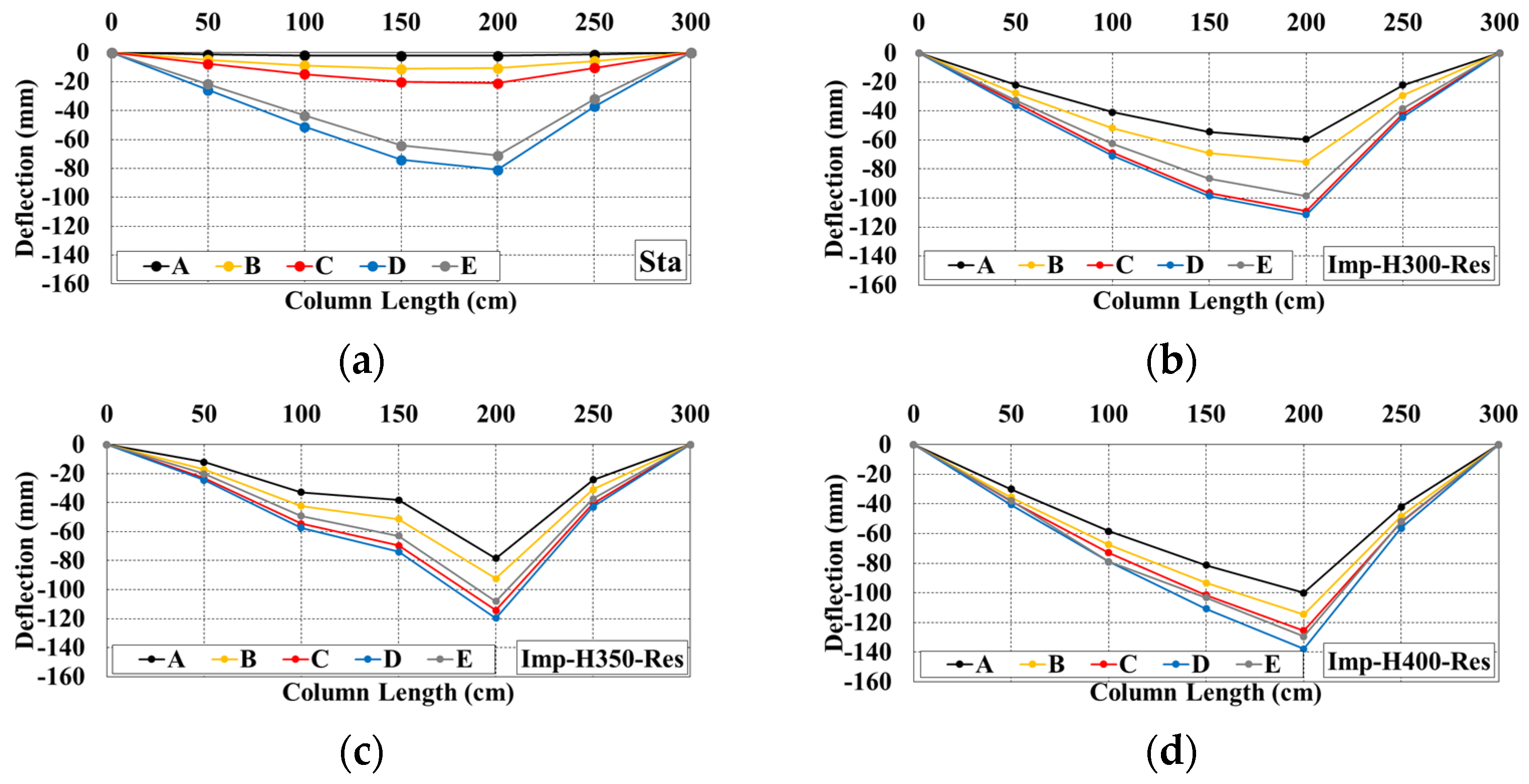

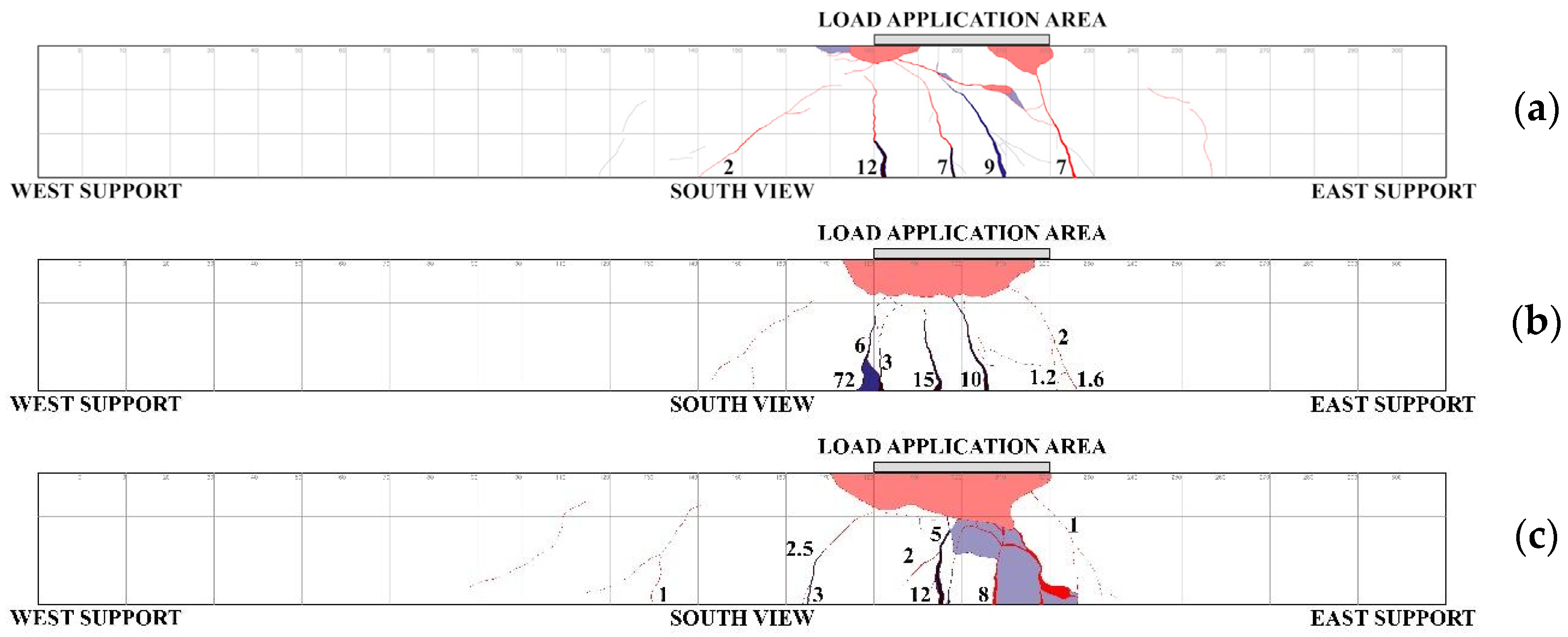
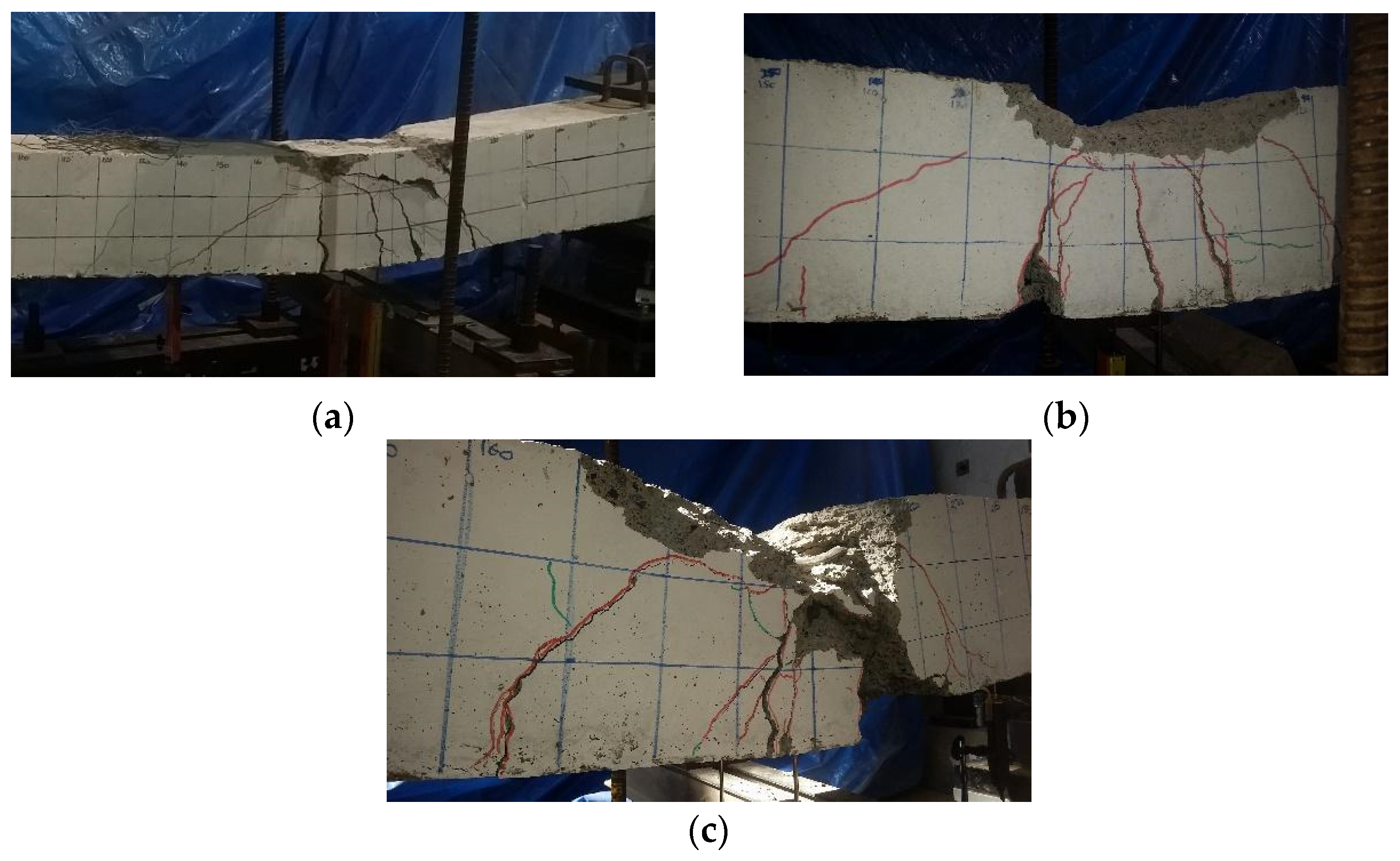

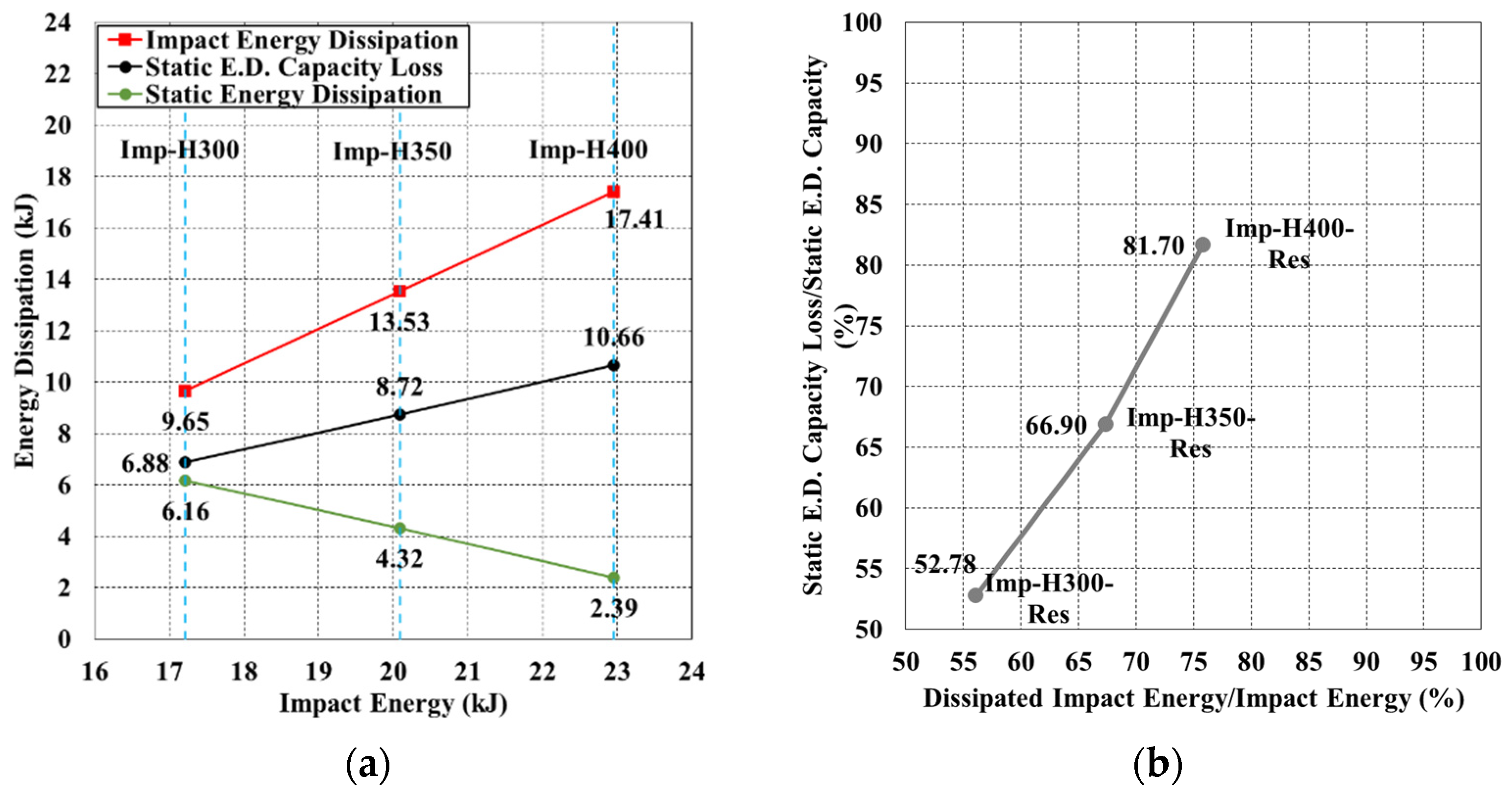
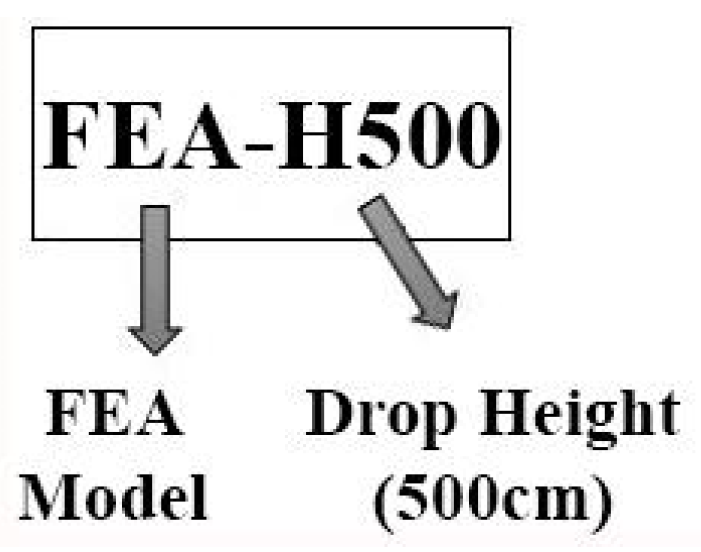
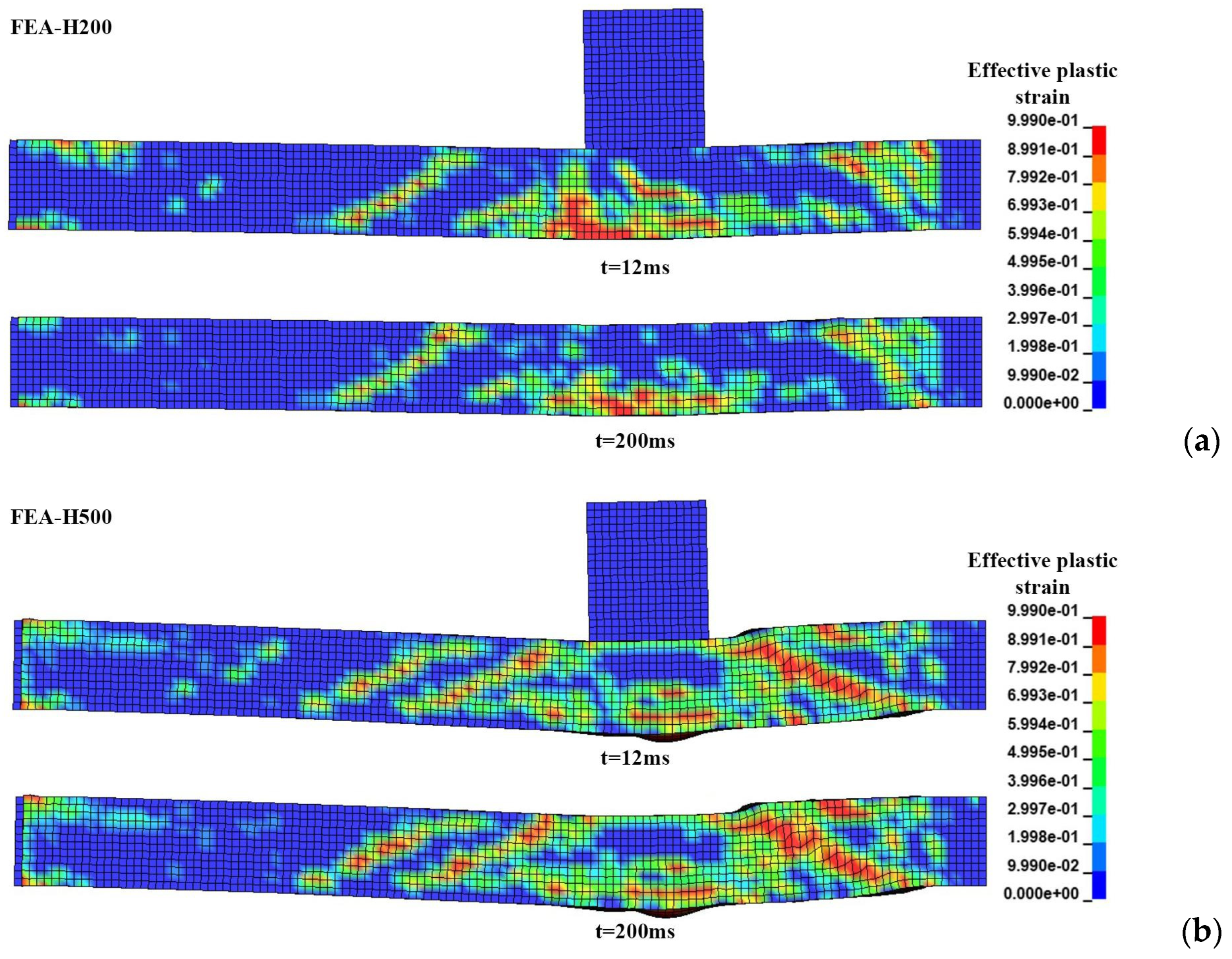
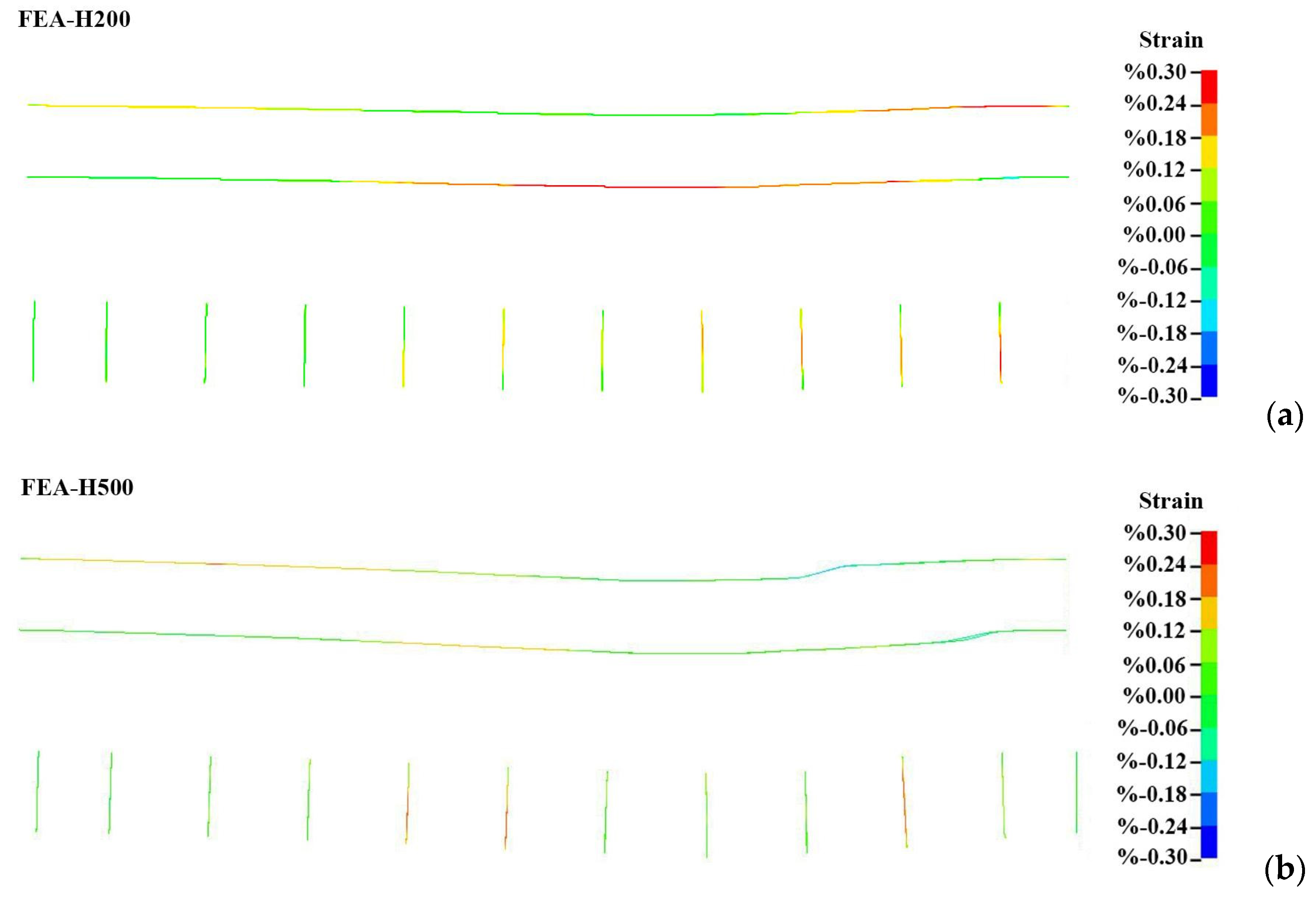



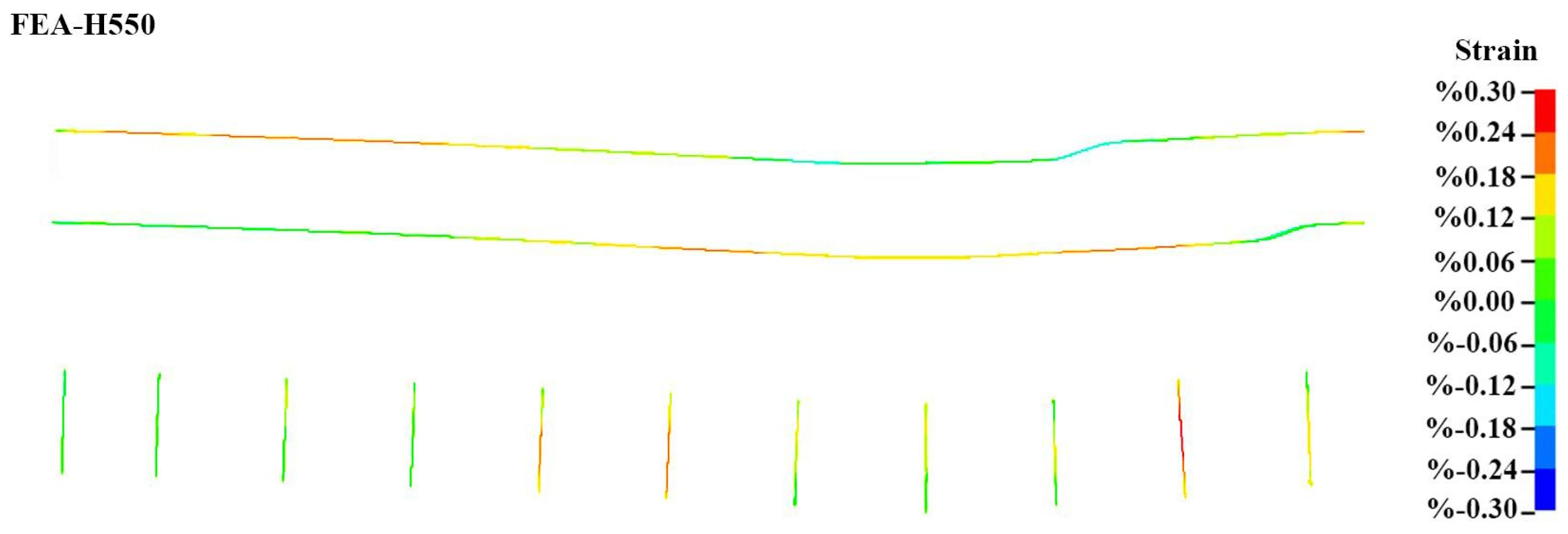
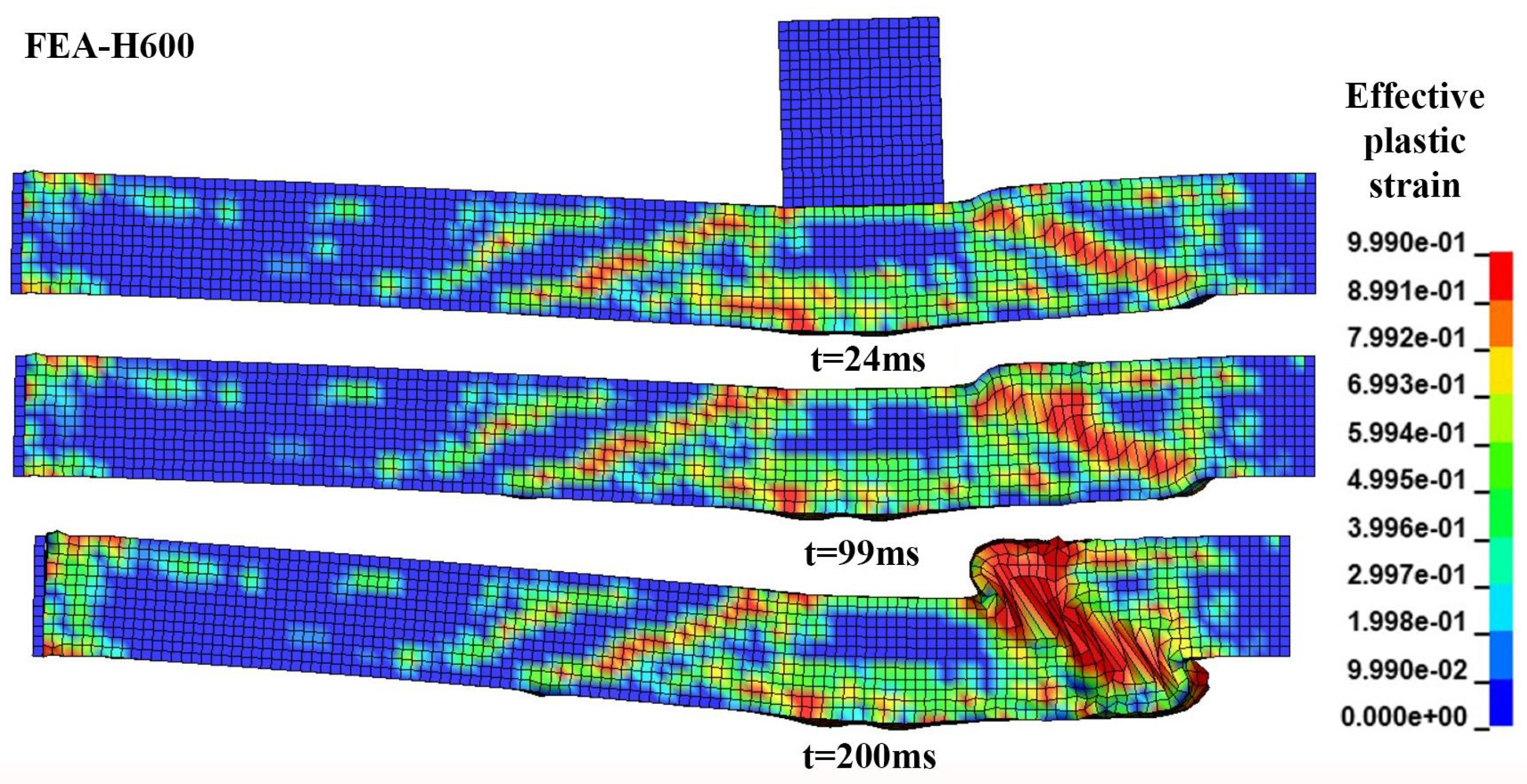
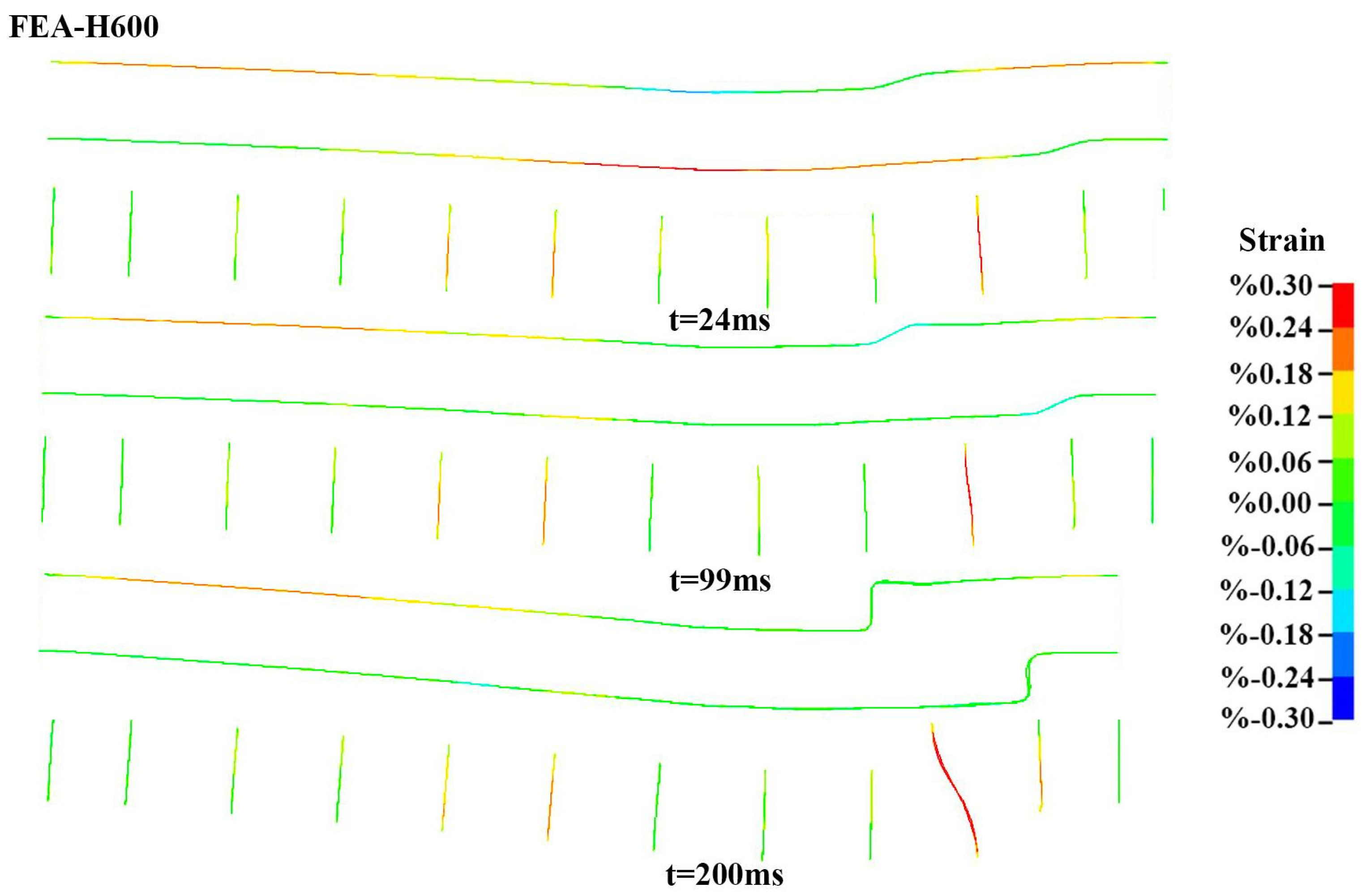

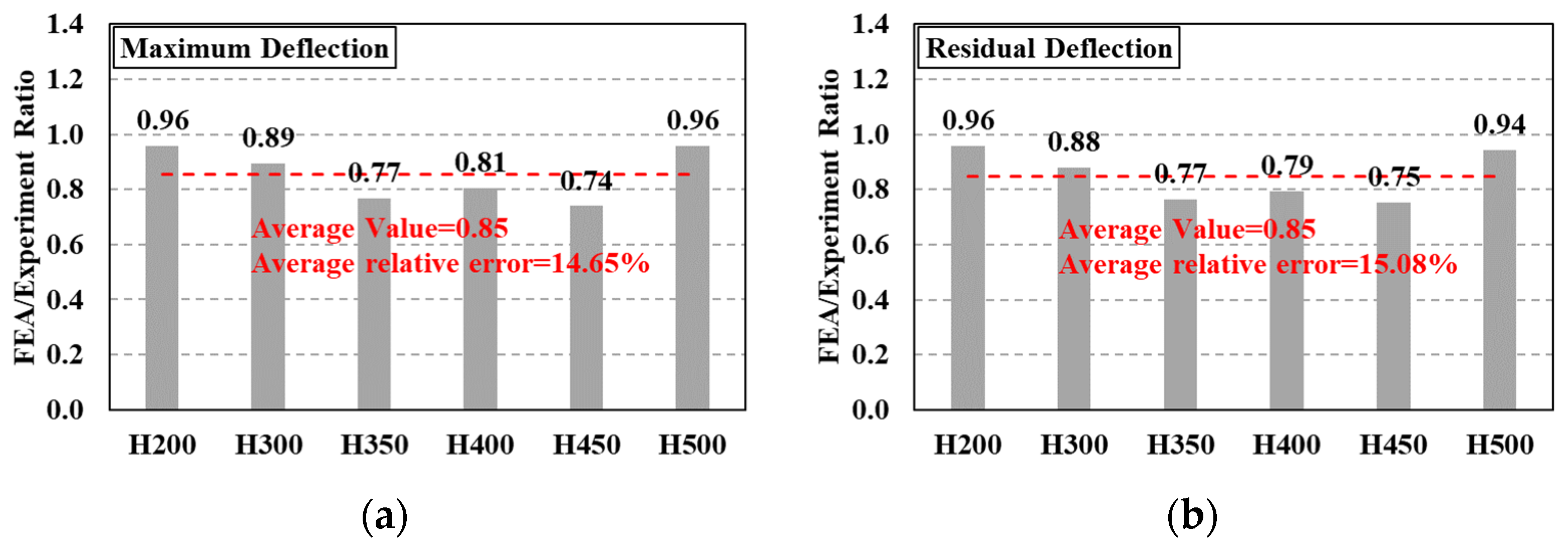
| Specimen Name | Drop Height (m) | Impact Velocity (m/s2) | Impact Energy (kJ) | Residual Static Capacity Test |
|---|---|---|---|---|
| Sta | Static Loading | Static Loading | Static Loading | Static Loading |
| Imp-H200 | 2.00 | 6.26 | 11.48 | - |
| Imp-H300 | 3.00 | 7.67 | 17.22 | Imp-H300-Res |
| Imp-H350 | 3.50 | 8.29 | 20.09 | Imp-H350-Res |
| Imp-H400 | 4.00 | 8.86 | 22.96 | Imp-H400-Res |
| Imp-H450 | 4.50 | 9.40 | 25.82 | - |
| Imp-H500 | 5.00 | 9.90 | 28.69 | - |
| Mix proportion and compressive strength of concrete. | |||||
| Cement (kg/m3) | Water (kg/m3) | No. I aggregate and sand (kg/m3) | No. II aggregate (kg/m3) | Max aggregate size (mm) | Compressive strength, fc’ (MPa) |
| 245 | 162 | 384 | 1573 | 22 | 30.9 |
| Mechanical properties of steel rebars. | |||||
| Rebar type | Diameter (mm) | Yield Strength (MPa) | Ultimate Strength (MPa) | Modulus of Elasticity (GPa) | |
| Longitudinal rebar | 18 | 459 | 538 | 200.5 | |
| Transverse rebar | 8 | 501 | 630 | 202.9 | |
| Specimen Name | Drop Height (m) | Governed Behavior | Max. Total Support Reactions (kN) | Deflections at P200 Potentiometer (mm) | Maximum Crack Width (mm) | Maximum Strains on Rebar (%) | Buckling on Longitudinal Rebar | |||
|---|---|---|---|---|---|---|---|---|---|---|
| Maximum | Residual | Shear | Flexure | Longitudinal | Transverse | |||||
| Sta | Static | Flexure | - | - | - | - | - | - | - | - |
| Imp-H200 | 2.00 | Flexure | 461 | 35.0 | 31.5 | <1 | 8 | +0.30 | −0.05 | - |
| Imp-H300 | 3.00 | Flexure | 472 | 61.0 | 59.6 | 2 | 10 | +0.56 | +0.37 | - |
| Imp-H350 | 3.50 | Shear/Flexure | 444 | 78.5 | 78.4 | 3 | 13 | +0.56 | +0.67 | - |
| Imp-H400 | 4.00 | Shear/Flexure | 442 | 102.0 | 100.1 | 5 | 12 | +0.53 | +0.22 | + |
| Imp-H450 | 4.50 | Shear/Flexure | 498 | 111.0 | 105.5 | 15 | 15 | +0.50 | +0.71 | + |
| Imp-H500 | 5.00 | Shear | 389 | 107.0 | 105.7 | 15 | 20 | +0.67 | +0.32 | + |
| Specimen | EIsta or EIres (MPa) | EIres/EIsta |
|---|---|---|
| Sta | 15.516 | - |
| Imp-H300-Res | 8.619 | 55.55% |
| Imp-H350-Res | 7.916 | 51.02% |
| Imp-H400-Res | 5.912 | 38.10% |
| Specimen | P200 Deflection (mm) | Static Residual Load Carrying Capacity (kN) | |||
|---|---|---|---|---|---|
| Impact Loading | Static Loading | ||||
| Maximum | Residual | Maximum (Imp + Sta) | Residual (Imp + Sta) | ||
| Sta | 0.0 | 0.0 | 81.1 | 71.2 | 176.9 |
| Imp-H300-Res | 62.0 | 59.6 | 111.5 | 98.7 | 157.1 |
| Imp-H350-Res | 78.5 | 78.4 | 119.6 | 108.0 | 132.0 |
| Imp-H400-Res | 102.0 | 100.1 | 137.9 | 129.5 | 89.0 |
| Specimen | Max. Support Reaction (kN) | Maximum Deflection (mm) | Residual Deflection (mm) | Longitudinal Rebar | Transverse Rebar | |
|---|---|---|---|---|---|---|
| Yielding | Buckling | Yielding | ||||
| Imp-H200 | 461 | 35.0 | 31.5 | + | − | − |
| FEA-H200 | 430 | 33.5 | 30.2 | + | − | + |
| Imp-H300 | 472 | 61.0 | 59.6 | + | − | + |
| FEA-H300 | 461 | 54.5 | 52.5 | + | − | + |
| Imp-H350 | 444 | 78.5 | 78.4 | + | − | + |
| FEA-H350 | 447 | 60.3 | 60.0 | + | + | + |
| Imp-H400 | 442 | 102.0 | 100.1 | + | + | + |
| FEA-H400 | 459 | 82.2 | 79.5 | + | + | + |
| Imp-H450 | 498 | 111.0 | 105.5 | + | + | + |
| FEA-H450 | 449 | 82.1 | 79.5 | + | + | + |
| Imp-H500 | 389 | 107.0 | 105.7 | + | + | + |
| FEA-H500 | 425 | 102.4 | 99.6 | + | + | + |
Disclaimer/Publisher’s Note: The statements, opinions and data contained in all publications are solely those of the individual author(s) and contributor(s) and not of MDPI and/or the editor(s). MDPI and/or the editor(s) disclaim responsibility for any injury to people or property resulting from any ideas, methods, instructions or products referred to in the content. |
© 2023 by the authors. Licensee MDPI, Basel, Switzerland. This article is an open access article distributed under the terms and conditions of the Creative Commons Attribution (CC BY) license (https://creativecommons.org/licenses/by/4.0/).
Share and Cite
Cengiz, A.; Gurbuz, T.; Ilki, A.; Aydogan, M. Dynamic and Residual Static Behavior of Axially Loaded RC Columns Subjected to Low-Elevation Impact Loading. Buildings 2024, 14, 92. https://doi.org/10.3390/buildings14010092
Cengiz A, Gurbuz T, Ilki A, Aydogan M. Dynamic and Residual Static Behavior of Axially Loaded RC Columns Subjected to Low-Elevation Impact Loading. Buildings. 2024; 14(1):92. https://doi.org/10.3390/buildings14010092
Chicago/Turabian StyleCengiz, Abdullah, Tuba Gurbuz, Alper Ilki, and Metin Aydogan. 2024. "Dynamic and Residual Static Behavior of Axially Loaded RC Columns Subjected to Low-Elevation Impact Loading" Buildings 14, no. 1: 92. https://doi.org/10.3390/buildings14010092
APA StyleCengiz, A., Gurbuz, T., Ilki, A., & Aydogan, M. (2024). Dynamic and Residual Static Behavior of Axially Loaded RC Columns Subjected to Low-Elevation Impact Loading. Buildings, 14(1), 92. https://doi.org/10.3390/buildings14010092







